









The fastest and easiest way to reach the Gilis from Bali is by fast boat. Alternatively, fly to Lombok and transfer to the Gilis from the mainland. Explore both these options below.
Fast Boats: With Lombok’s airport based in Central Lombok, around 2 hours travel time from the Gilis, fast boat services are a popular option to flying, and provide fast and easy transfers between Bali and the Gilis.
Most fast boats leave Bali from either Serangan Harbour in the south of Bali or from Padang Bai Harbour in East Bali. In good weather, fast boats can make the crossing in around 90 minutes but in heavy seas the trip can take two hours or more. Travel time also depends on the size of the boat, the boat’s engines, and from which harbour your boat departs.
If your fast boat departs from Benoa or Serangan harbours, you will spend less time travelling to the harbour from the main tourist areas in south Bali (around 30 minutes) but more time on the water (around 2 ½ hours).
Harbour on the northwest of Lombok for port clearance and then making the return trip to Bali (they cannot leave direct from the Gilis back to Bali without first clearing the port authority at Bangsal).
People travelling to Gili Meno also need to note that only Eka Jaya fast boats travel to Gili Meno. If you are travelling on another boat, you must disembark at Gili Trawangan and either catch the public ferry or charter a smaller boat to make the short crossing to Gili Meno.
The Lombok Strait – between Bali and Lombok – is one of the deepest bodies of water in the region and, during certain times of the year, waves can reach up to 4 metres high – at which time, fast boat services will often be cancelled.

If your fast boat departs from Padang Bai Harbour, in the east of Bali, travel time from Kuta, Legian, Seminyak, Sanur, etc., to Padang Bai is around 2 hours. The crossing to the Gilis then takes around 1 ½ hours.
If you are staying in Ubud, Candidasa or the north of Bali, it makes sense to leave from Padang Bai.
Also note that some fast boats stop off at Nusa Lembongan and Nusa Penida (islands off Bali) enroute. Check boat schedules to check what route the boat travels.
Fast boats travel from Bali to Gili Trawangan and Gili Air before crossing to Bangsal
Although this only happens a couple of times a year, always check sea conditions before travelling and choose a fast boat operator that will arrange for alternative transport or a refund if your trip is cancelled.
As there are so many boats to choose from, search the internet for “Gili fast boat” to check other travellers’ reviews and choose a reliable operator. Avoid companies that practice “over loading” in busy times or who have poor safety records.
Gili Getaway is a well-established and professional company with an exceptional safety record and good customer service.
by
Their comfortable fast boats depart from Serangan Harbour daily to Gili T, Gili Air, and Bangsal Harbour, Lombok, as well as to Gili Gede in Southwest Lombok.
Fares include air-conditioned hotel transfers to main points in Bali. www.giligetaway.com
Blue Water Express is another longrunning company with professional service and high safety standards. Boats depart from both Serangan Harbour and Padang Bai for convenience.
www.bluewater-express.com
Eka Jaya is a popular large ferry with a capacity for 210 passengers. Although it can feel packed at times, its larger size makes for a more stable trip. Eka Jaya leaves from Padang Bai and travels to Senggigi (West Lombok), Bangsal Harbour, Gili Air, Gili Meno and Gili T before returning to Bali. They operate a shuttle service to/from Padang Bai and reasonably priced private car transfers can be booked through their website. www.ekajayafastboat.com
By Plane: Fly to Lombok International Airport and either stay on the mainland before making the trip out to the Gilis or arrange transport from the airport direct to the Gilis.
Drivers are waiting at the arrival hall at the airport and you can organise a taxi or private car and driver from the airport to Bangsal Harbour (approx 1 hour 45 minutes) and then catch a boat out to your preferred Gili.
HOTEL TRANSFERS: Many hotels on the islands provide speedboat transfers for guests, as well as pick up services from the airport in a private air-conditioned car. Although slightly more expensive than doing it yourself, it is a comfortable and easy way to travel to the Gilis – enquire at your hotel when you make your booking.
FROM BANGSAL HARBOUR: Catch a taxi or arrange a car and driver from the airport and travel to Bangsal Harbour, the main harbour to the Gilis on the northwest coast.
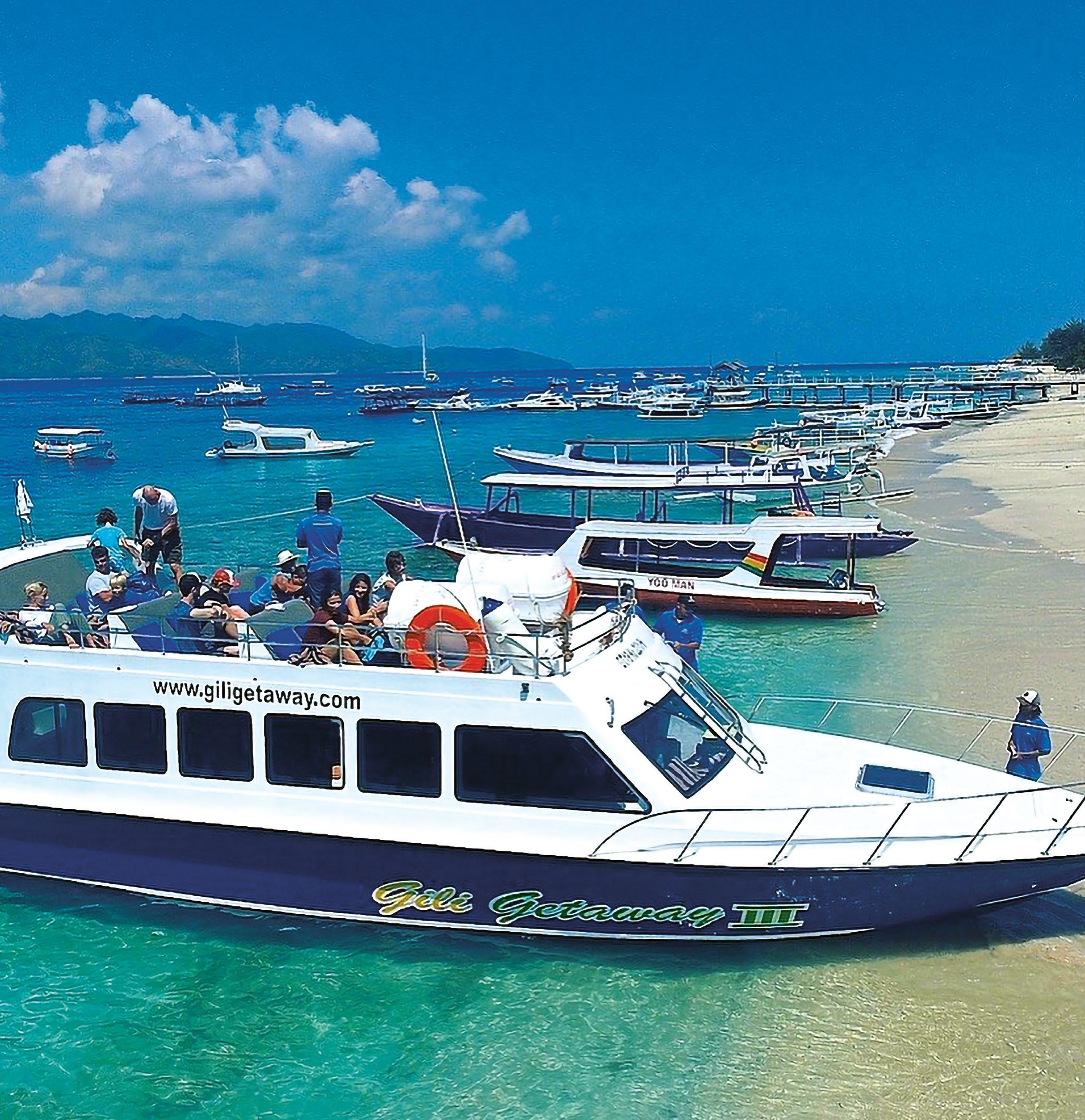


Continued from Page 2
Public ferries and public fast boats both operate from Bangsal. Tickets to the Gilis are available from behind the sign-posted ticket office on the beachfront (the blue and white building on the right-hand side as you enter the harbour). The ticket office is open 8am to 5pm.
Public fast boats carry up to 60 passengers and operate from Bangsal Harbour to the Gilis daily from 9am - 4pm; but it’s best to get there in the morning. Boats leave roughly every hour and Price is Rp 85,000 per person.
The large and comfortable fast boats do a circular route from Bangsal to Gili Air (5 mins), Gili Meno (10 mins) and Gili Trawangan (15 mins), and then return on the same route.
Fast boats also provide easy transfers between the islands (eg. Gili Air to Gili T), as they are travelling the circular route between each island every hour. There is a schedule on display near the ticket office in Bangsal and at each harbour on the islands.
Public ferries are large outrigger boats that carry up to 40 passengers. These boats are slower but are the cheapest option for island transfers and operate from 8am to 5pm. Departures are easier in the mornings.
Public ferries travel to each Gili separately and wait until they are full until they depart but, generally, boats to Gili Air depart every hour, and to Gili T every 2030 minutes. Boats to Gili Meno depart at 9am, 2pm and 5pm.
Approximate fares and travel times are Gili Air Rp 20,000 (20 mins), Meno Rp 25,000 (30 mins) and Trawangan Rp 25,000 (35 mins).
Private speedboat charters are also available from Bangsal and carry up to 6 passengers. This is a good option for groups and people who don’t want to wait for regular departure times.
Speedboat charter to Gili Air costs Rp 400,000, to Meno Rp 425,000 and to Gili T Rp 450,000, and includes insurance.
Fast Boats to Bali arrive and depart from the jetty at Bangsal. The check-in counters are behind the terminal building on the right of the harbour. There is Rp 10,000 departure tax payable on the jetty.
Individual ticket offices for the different fast boat operators are on the road just outside the gateway to the harbour –look for each company’s signs near the Mini Market.
Unfortunately Bangsal, like most ports in Indonesia, has its share of touts and scams The best way is to ignore them and head directly to the ticket office on the beachfront. Public ferry and charter boat prices are displayed clearly on the wall behind the ticket office.
Don’t let anyone take your bags or, if they offer to carry baggage, negotiate a price first. 10k per bag is reasonable. Ignore people who tell you that there are no return public transfers (there are); or that there is no water, mosquito repellent, etc., on the islands. All the essentials are readily available at shops on all three islands.
To catch a taxi from Bangsal, ask your hotel to call a Lombok Taxi before you leave the Gilis (or use the “My Blue Bird” taxi app). The taxi will be waiting in the parking area just a short walk outside the harbour entrance on the left-hand side.
Drivers at the harbour will also negotiate trips; prices are slightly higher than taxis but it’s a convenient option. See rates below.
Packages for climbing Mt Rinjani (via Senaru or Sembalun) are also available from Bangsal, as are day trips to popular tourist attractions. Always negotiate. These trips are also available from tour operators on the Gilis.
FROM TELUK NARA AND TELUK KODEK:
Teluk Nara is a large peaceful bay on the northwest coast, about 25 minutes’ drive north of Senggigi and a few minutes before Bangsal. Teluk Kodek is a smaller bay directly alongside. Many of the dive companies, hotels and businesses on the Gilis have boats moored here and transfer guests to the islands every day.
Negotiate a private speedboat out to the islands with local boat owners here, thereby avoiding the hassles of Bangsal. Speedboat charters are available to all three islands and are slightly cheaper than at Bangsal, depending on your bargaining skills.
FROM SENGGIGI: You can charter local outrigger boats from the beachfront in Senggigi (in front of the Art Markets). The trip out to the islands takes around 1 ½ hours.
The journey up the coast in the morning is very scenic, but you may get wet on the way back. Make sure you negotiate a price with the boatman first!
A good alternative is to check out the dive centres on the main street in Senggigi who offer reasonable rates for transfers, usually including pick up from your hotel.
Arranging snorkelling and dive trips inclusive of island transfers is a good way to save time, money and hassles if you aren’t staying on the Gilis, or if you spend time on the mainland and then want to transfer to the Gilis.
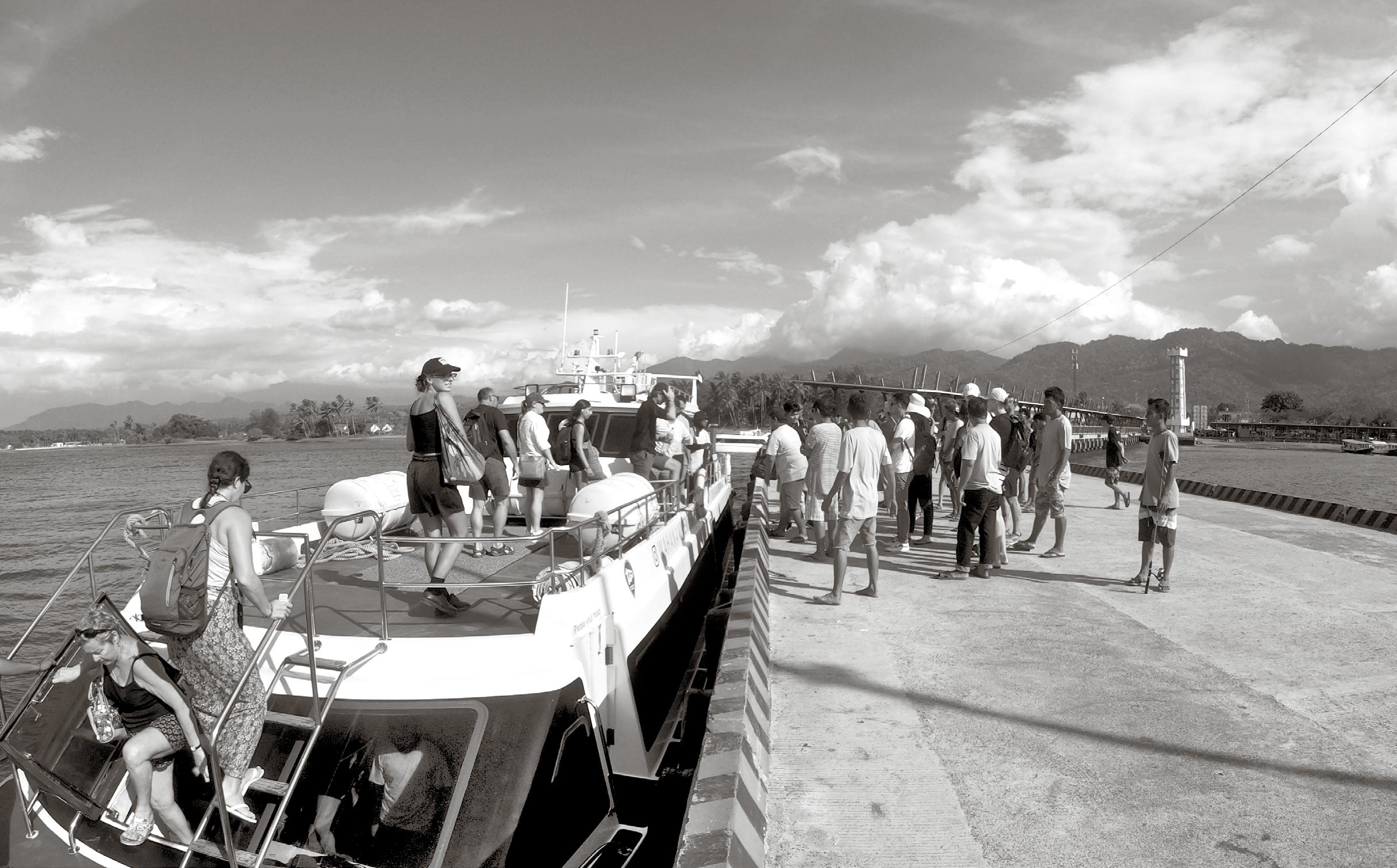

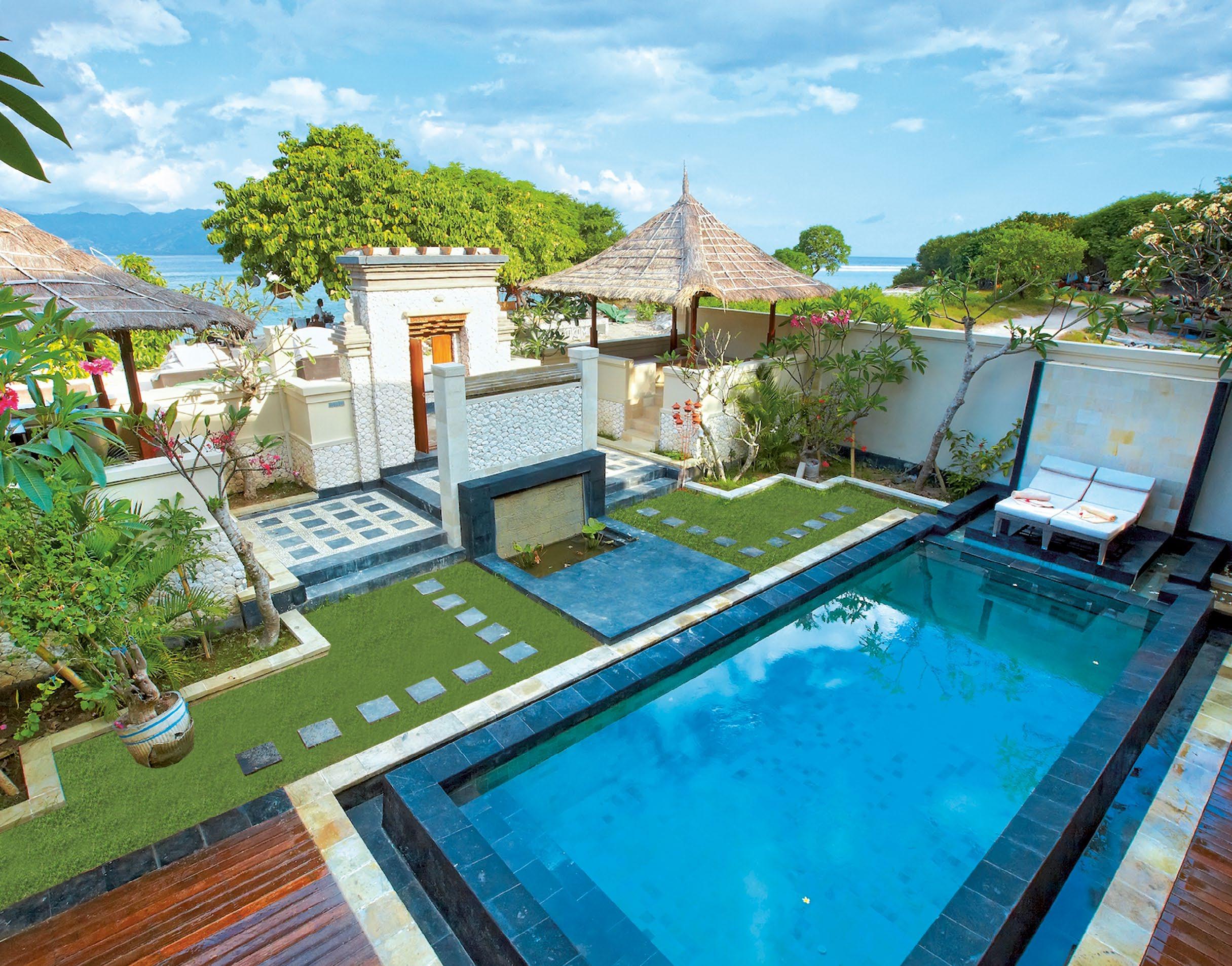
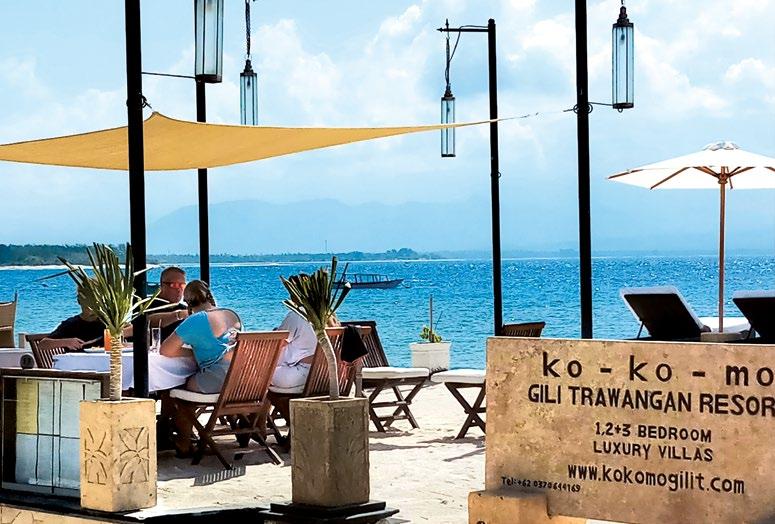
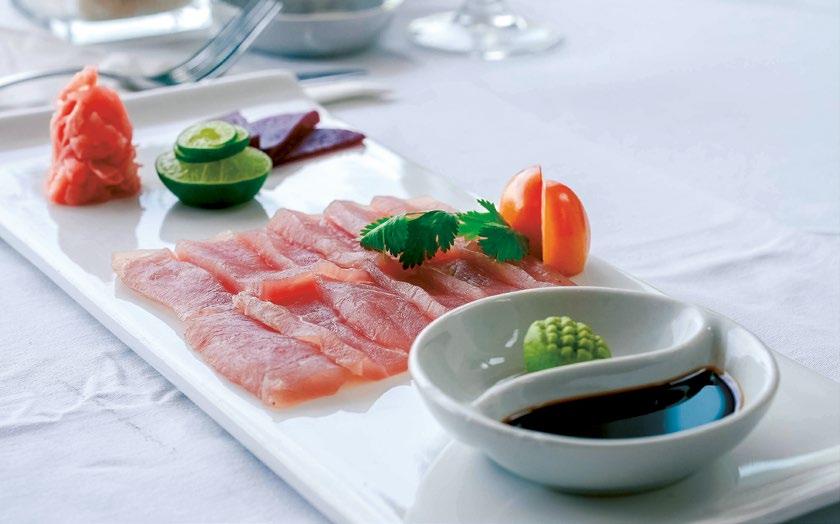
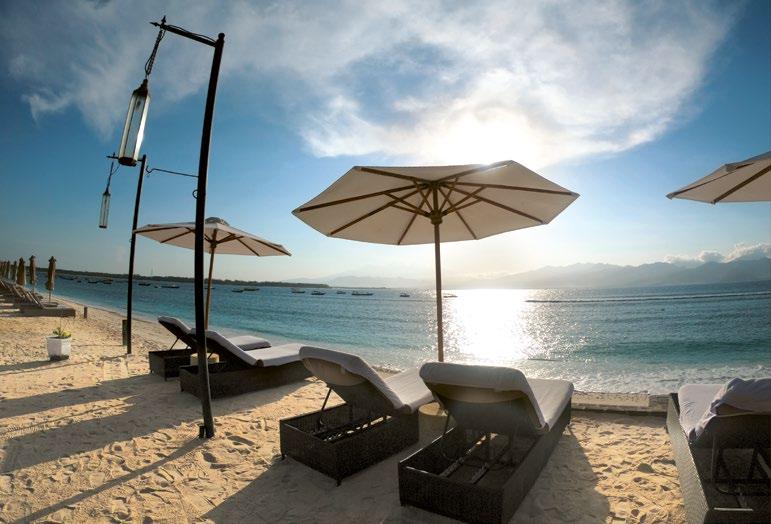
A calm oasis, close to all the action, but a world away... fronting onto a white sandy private beachfront, ko-ko-mo is a chic boutique villa resort, with a choice of 1 and 2 bedroom private villas, each with a pool or plunge pool, and one of the island's only 3 bedroom pool villas.
Get there fast, then take it slow... Email: kokomogilit@ozemail.com.au
The beachfront 5-star fine dining restaurant (overseen by our renowned ex-Sydney chef) offers a choice of dishes focusing on local produce, fresh seafood and top quality Australian imported meats.
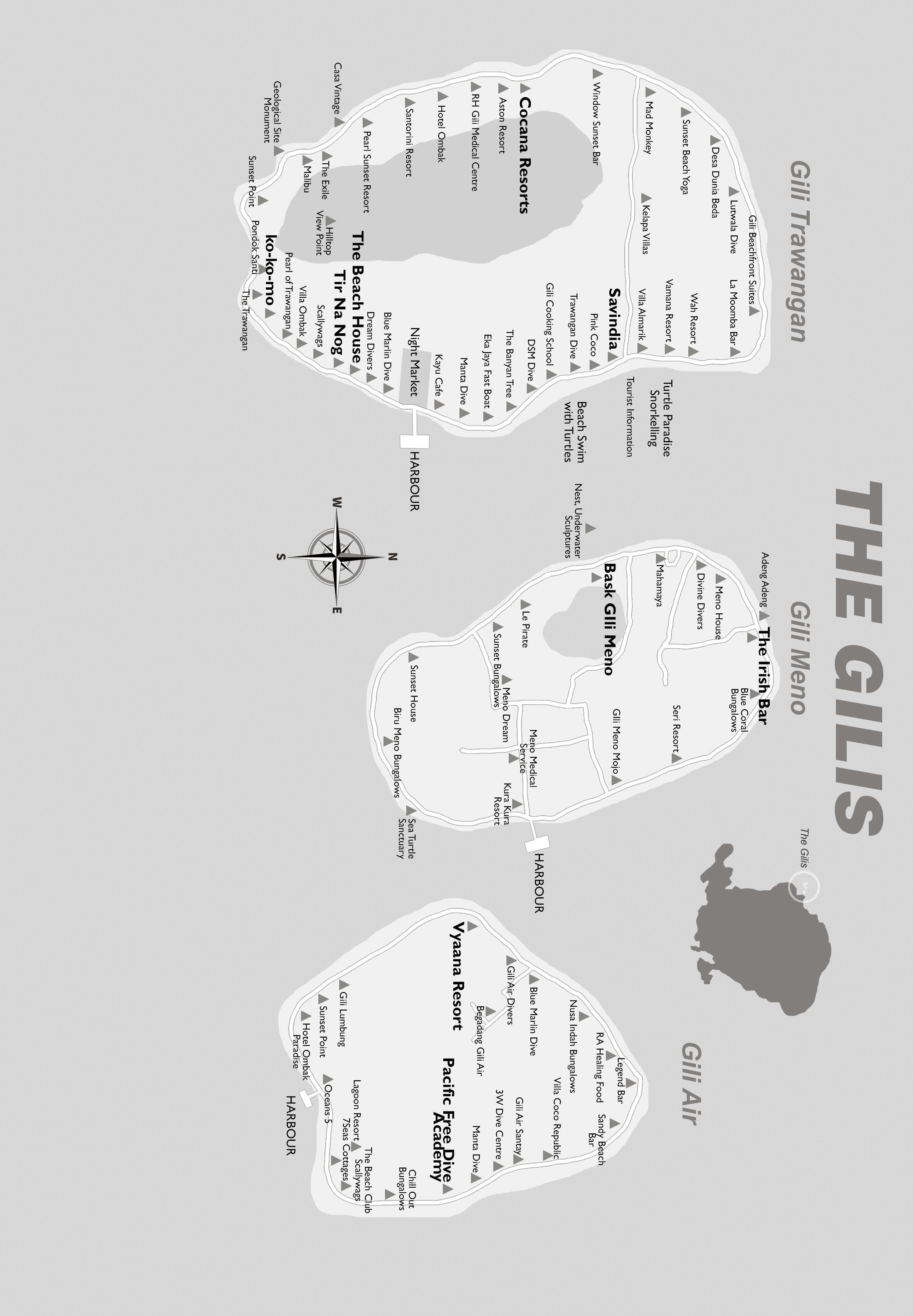
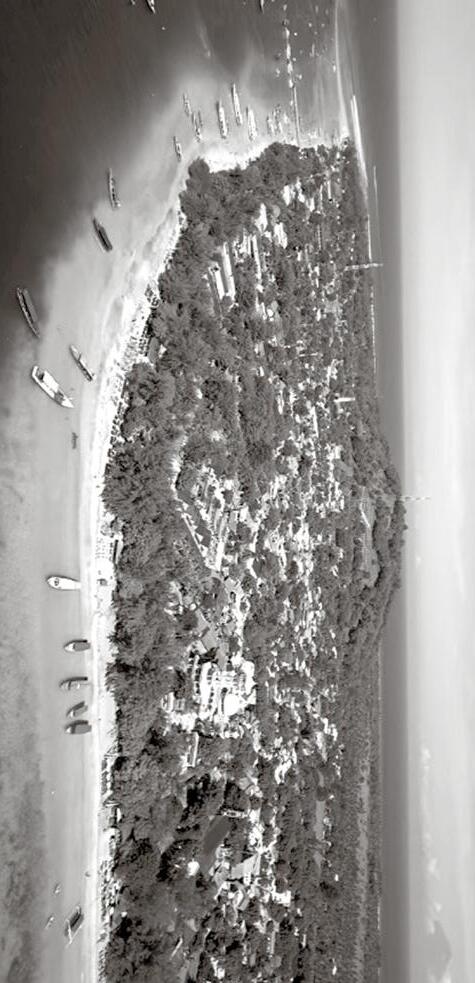
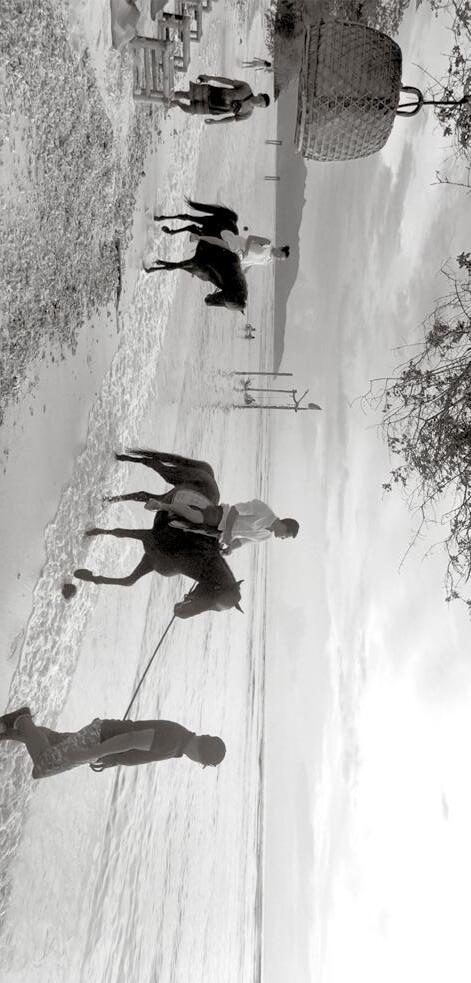


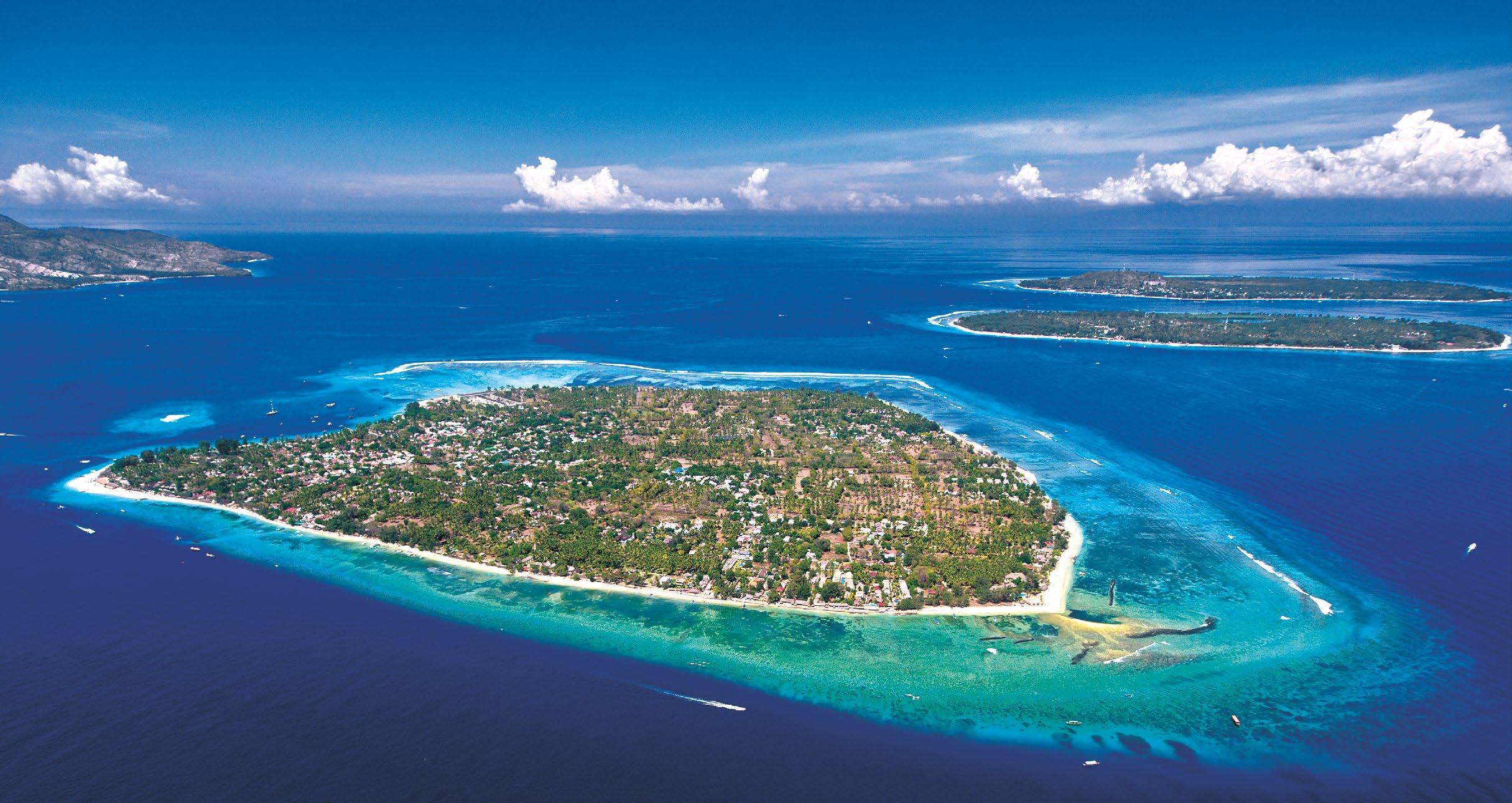
The Gilis, together with Rinjani volcano, are Lombok’s most famous attractions and are consistently rated among the top destinations in Southeast Asia by travellers and travel magazines.
Every year the Gilis attract tens of thousands of visitors from around the world for their incredibly clear aquamarine waters, unparalleled diving and irresistible laid-back charm. The word Gili actually means “small island” in the local dialect, and so these islands have come to be known as “The Gilis” by travellers.
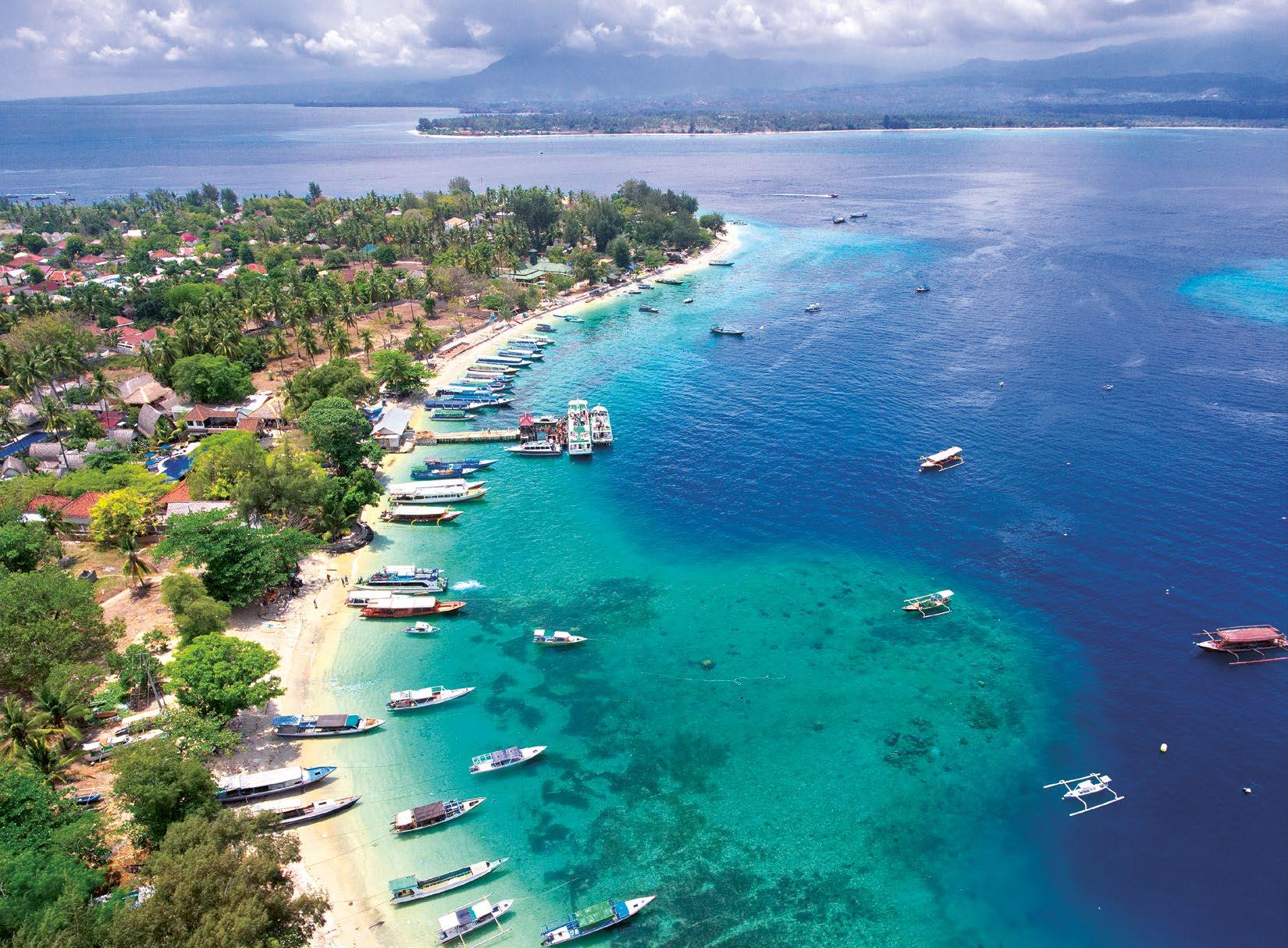
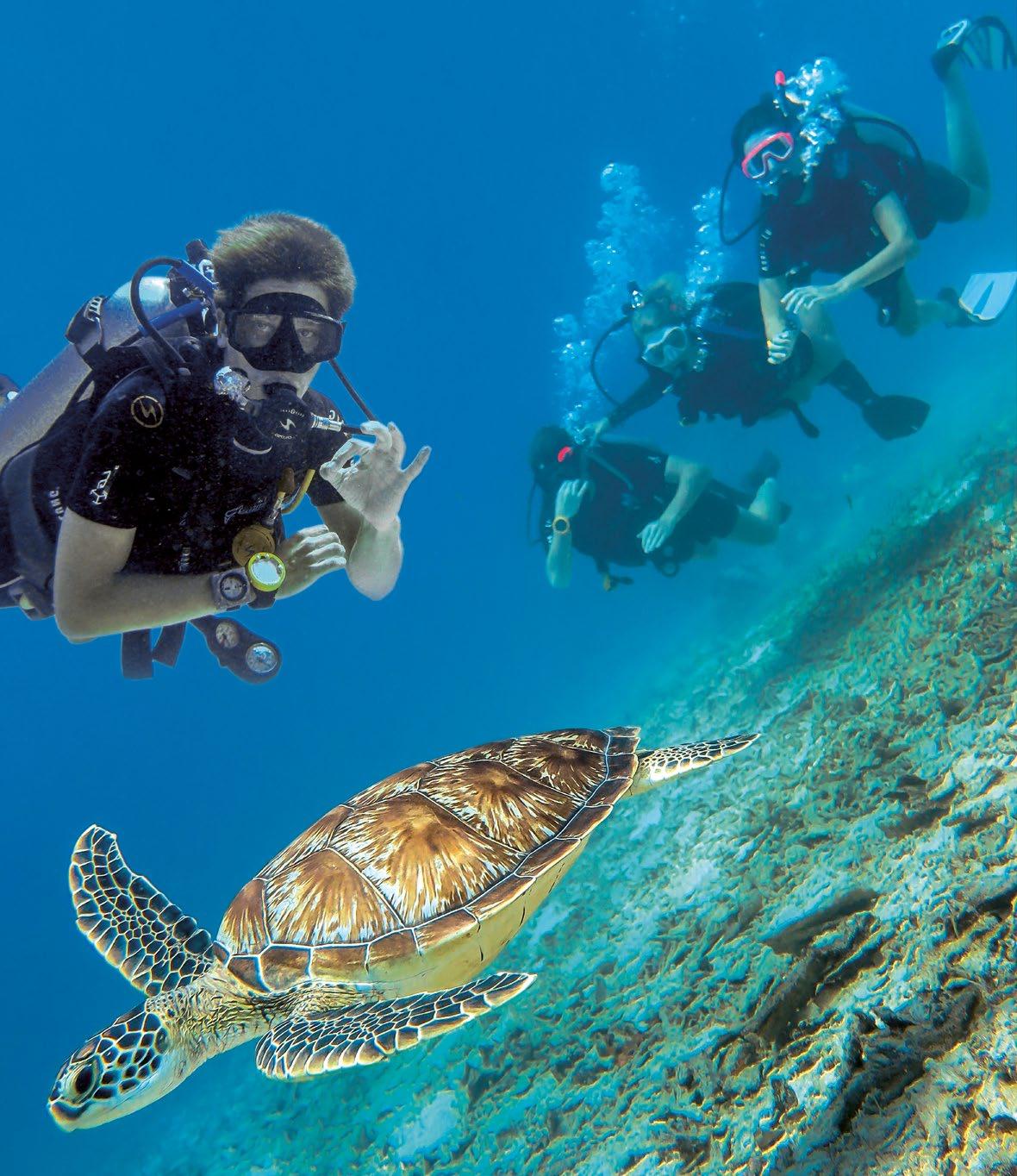
Today the Gilis attract a diverse range of visitors – from avid diving enthusiasts to sun-seekers looking for the perfect beach getaway – solo travellers, families, and couples of all ages find something to love about the Gilis.
There is a good selection of accommodation, restaurants and bars, and tourist facilities on all three islands, with the biggest range on Gili Trawangan.
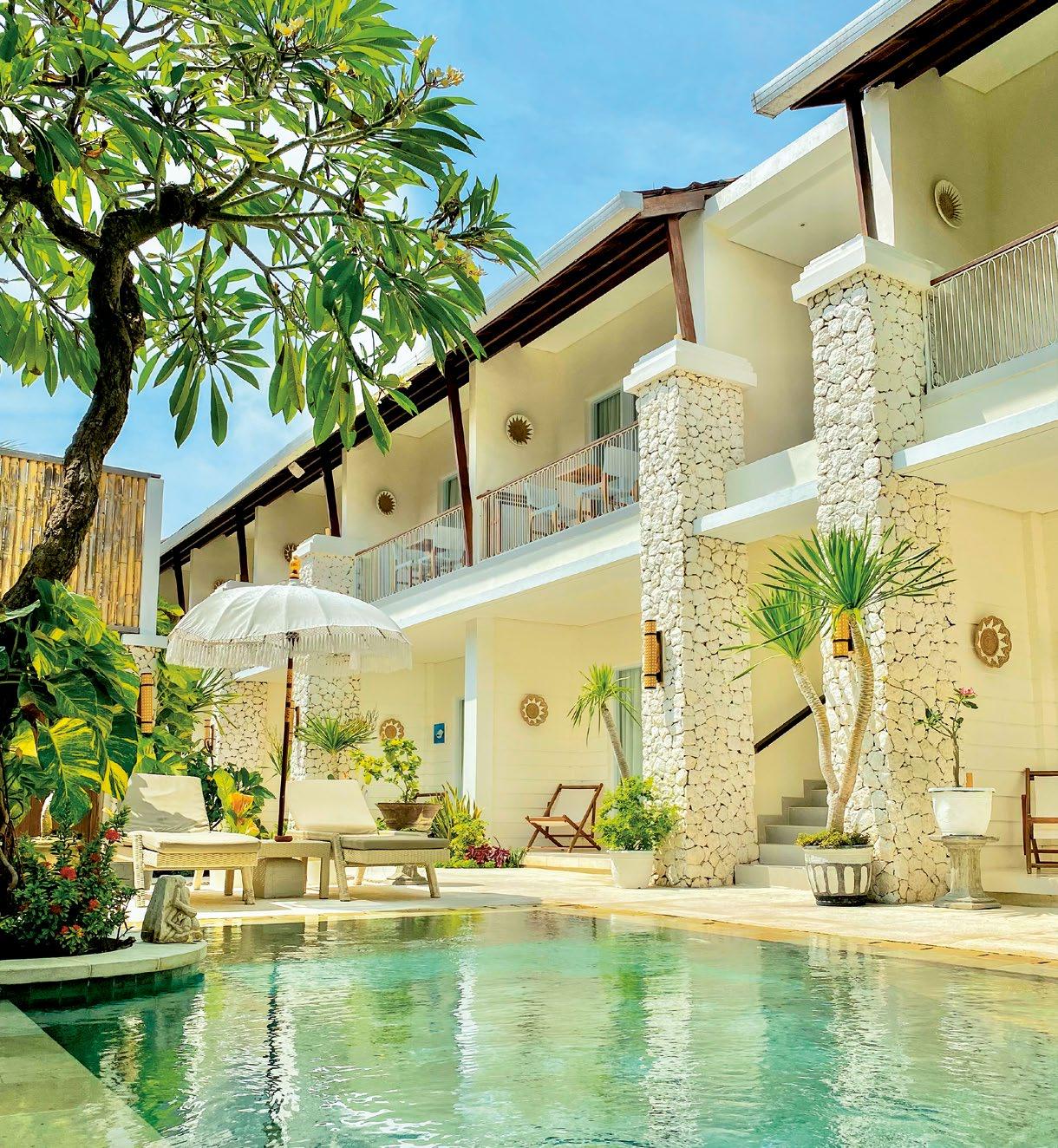
THE ORIGINAL AND THE BEST! Our Famous Seafood Barbecue Every Night
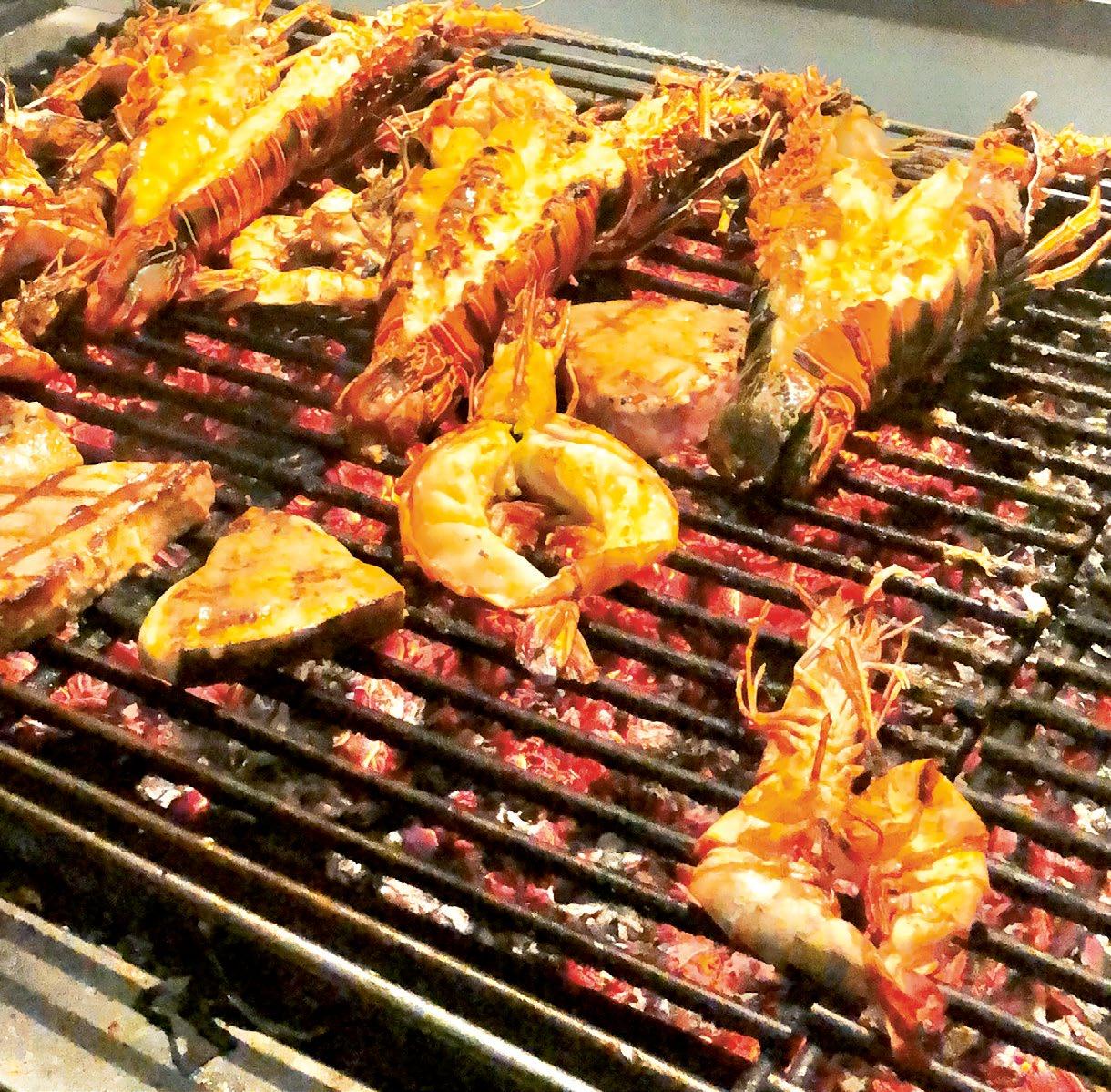
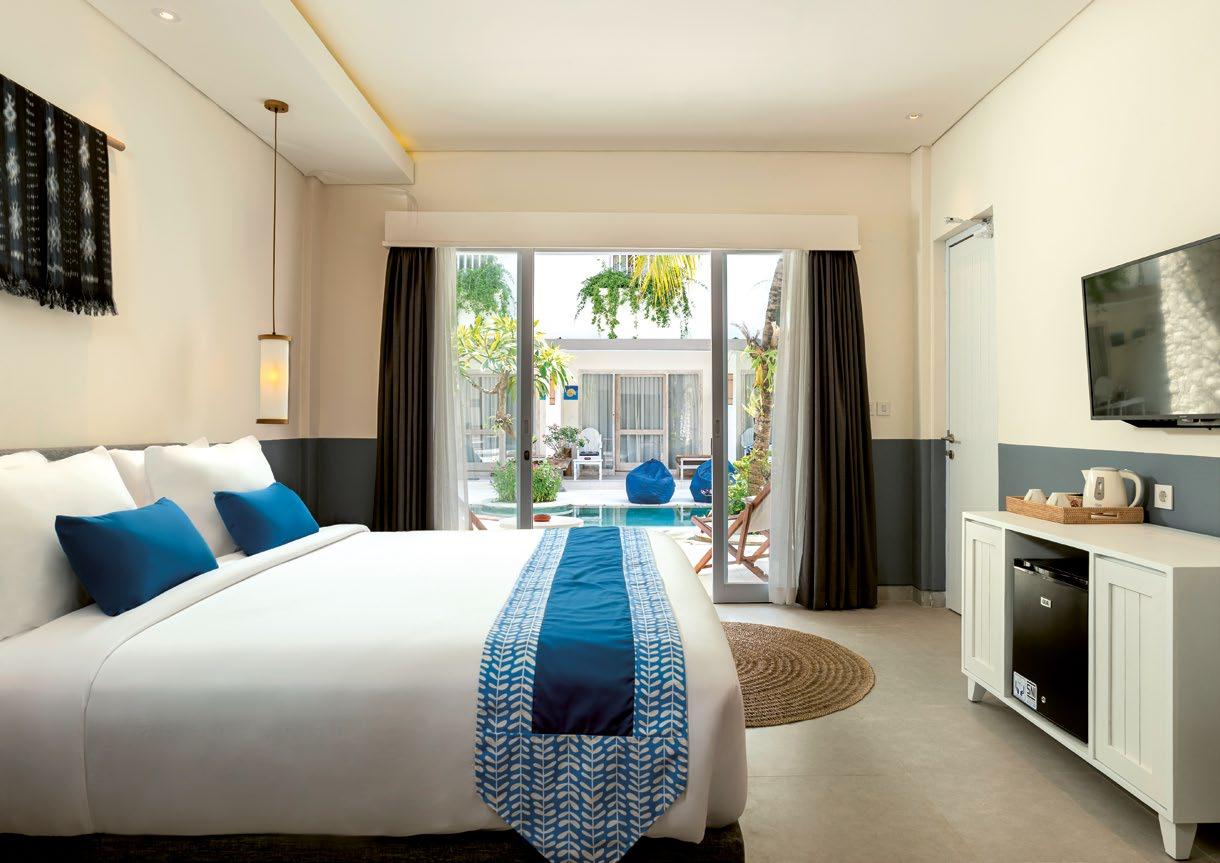
Luxurious Rooms, Suites, and 1 and 2 Bedroom Pool Villas Just Steps from the Beach
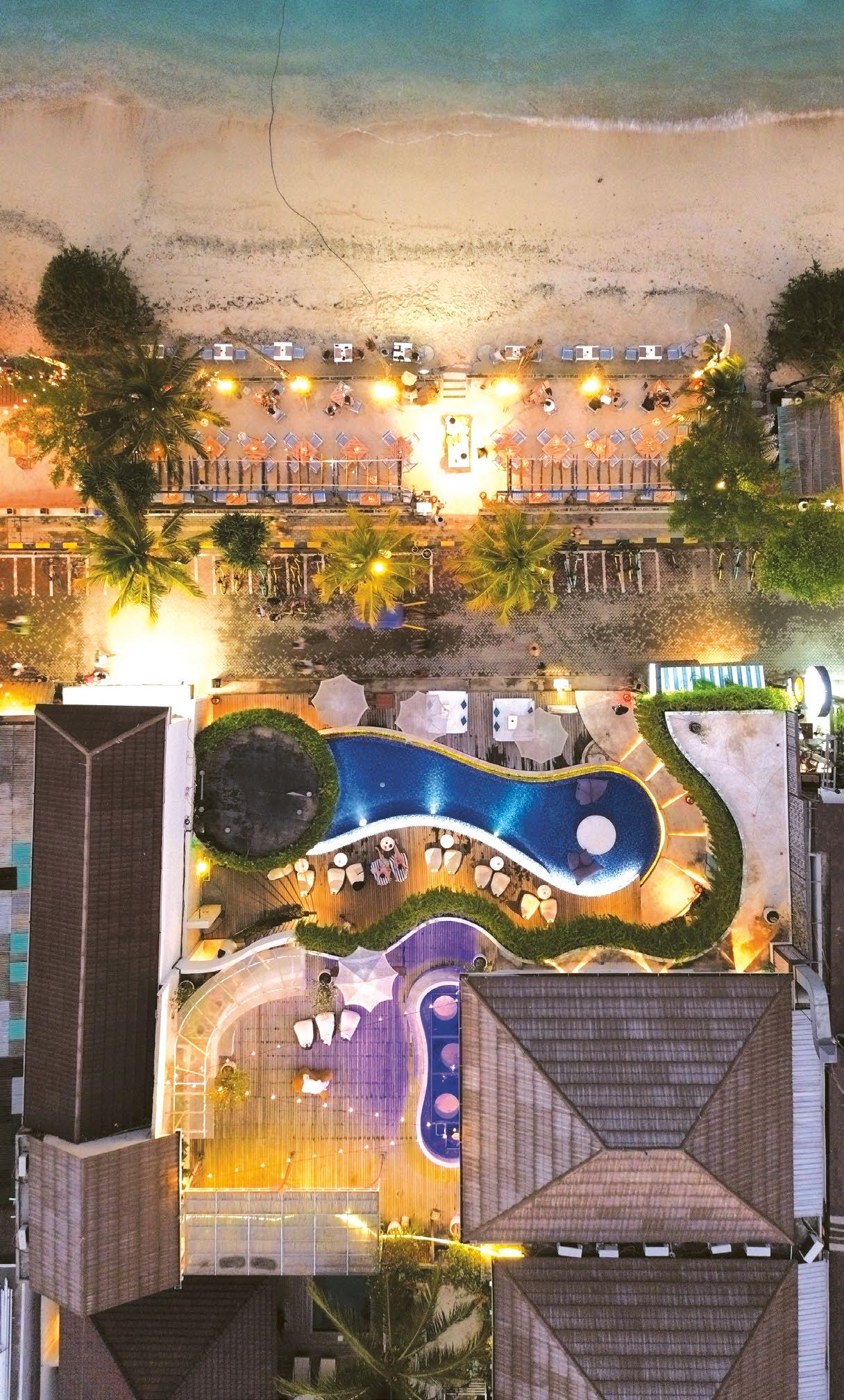
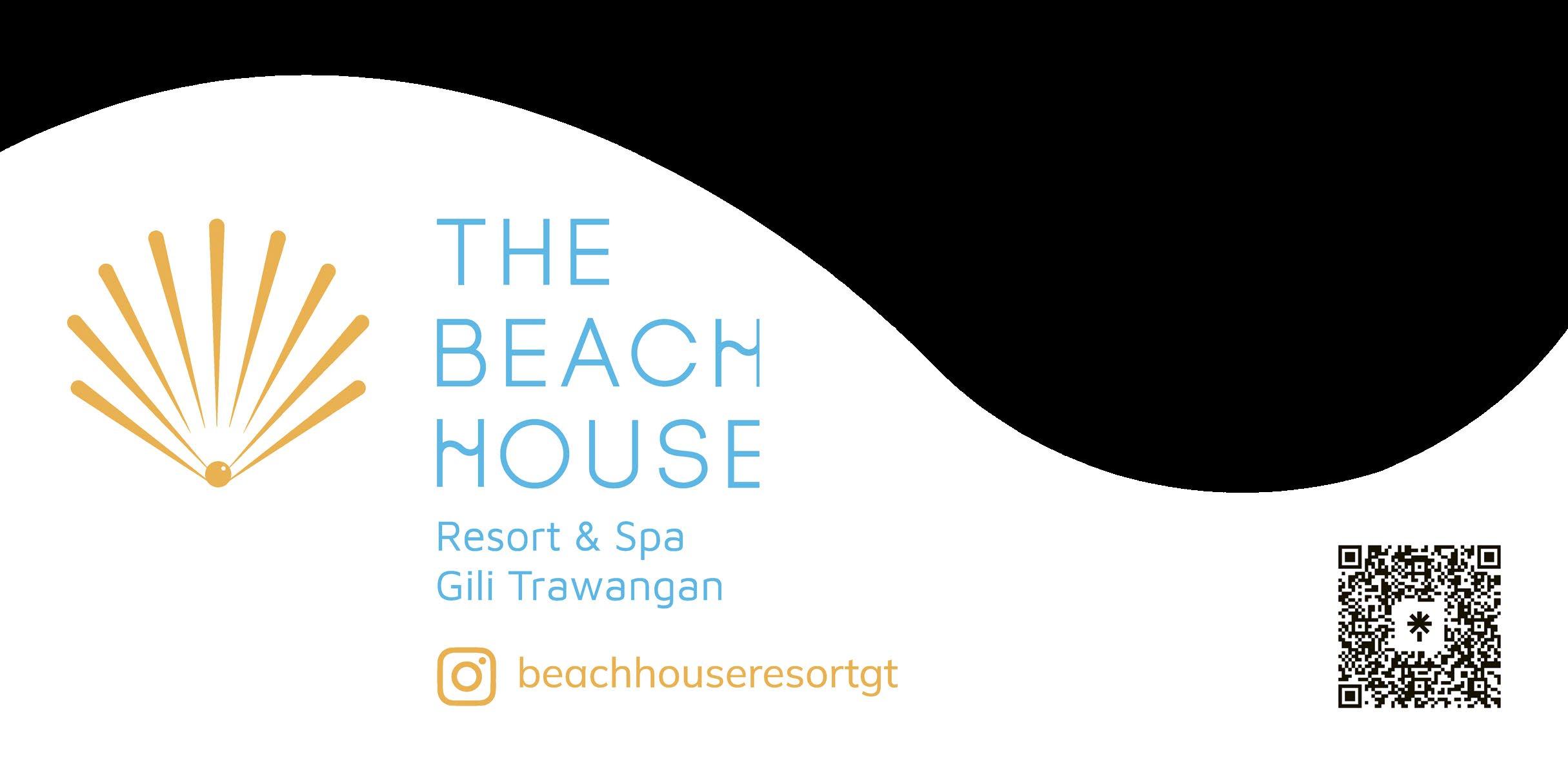

Continued from Page 8
Activities include exceptional diving and snorkelling, glass-bottom boat excursions, island-hopping adventures, cycling around the island, horseback riding on sandy beaches, rejuvenating yoga sessions and indulgent massages, as well as surfing, SUP and all kinds of water-based activities.
The islands provide ample opportunities for visitors to snorkel and scuba dive with the many internationally accredited dive operators based in Lombok.
The pristine waters are home to an abundant variety of corals and thousands of species of tropical fish and an impressive array of aquatic life can be found here, including green and hawksbill turtles, moray eels, barracuda, reef sharks, occasionally leopard sharks and manta rays, and more.


Visibility is very good and commonly in the 15-30 m range; and water temperatures average 23°C (73°F) to 29°C (84°F).
Many of the popular dive companies are owned and operated by westerners and are PADI and SSI licensed dive operators, with professional standards of safety and environmental awareness.
Each Gili, having evolved independently and at its own pace, possesses a distinct personality and style. This diversity ensures that every traveller finds their perfect island escape, depending on their individual tastes and desires.


JOIN US FOR PORN STAR MARTINI'S AND OTHER DELICIOUS COCKTAILS AT SAVINDIA THIS MONTH - ONLY 50K+ ALL DAY, EVERY DAY!
Gili T's #1 Beachfront Lounge - Chill Out All Day and Night!

Gili Trawangan, or “Gili T” as its affectionately known, is the largest and most developed of the three Gilis, with the greatest range of facilities and activities.
It is the furthest island from the mainland, but is easily reached from Bali in less than 2 hours and is only 10 minutes by speedboat from Lombok.
Stretching approximately 3km in length and 2km in width, getting around Gili T on foot is easy, while a leisurely cycle around the island takes around 1 ½ hours – though, be prepared for some sandy detours in the north.
It's the only Gili that elevates significantly above sea level, with the hill in the south offering a breathtaking vantage point for spectacular sunsets across the ocean to Bali or the brilliant sunrise over Mt Rinjani on mainland Lombok.
Tagged “the party island”, Gili T continues to cater to the party crowd but also has a cosmopolitan vibe that is continually evolving. TripAdvisor® recently rated it as one of the ‘Top 10 Islands in Asia’.
Continued from Page 10
On the far south end of the hill are the remnants of old WWII Japanese gun emplacements and crumbling bunkers, but the hand-dug tunnels have been blocked up.
The busiest area on Gili T is the east coast, but Gili T’s popularity means hotels and cafés extend around the entire island.
Accommodations cater to diverse preferences, ranging from modest budget options to mid-range and opulent hotels, along with private villas that promise something for every discerning traveler.
Cafés and restaurants rate highly in quality and choice, and there are beachside dining options galore. Choices range from fresh seafood and modern healthy
creations to authentic Indian, Italian and international cuisines; and from inexpensive Indonesian dishes to sophisticated fine dining.
Even the shopping scene on Gili T is evolving. Shops and kiosks selling the usual sarongs and t-shirts now rub shoulders with brand outlets and stylish boutiques.
Come nightfall, Gili T comes alive with a vibrant bar scene and regular parties around the island. The island has a rotating roster, where different bars have licenses to host a party on one night of the week. These parties are a big draw-card for the crowds of younger people who come to the island.
Continued on Page 14
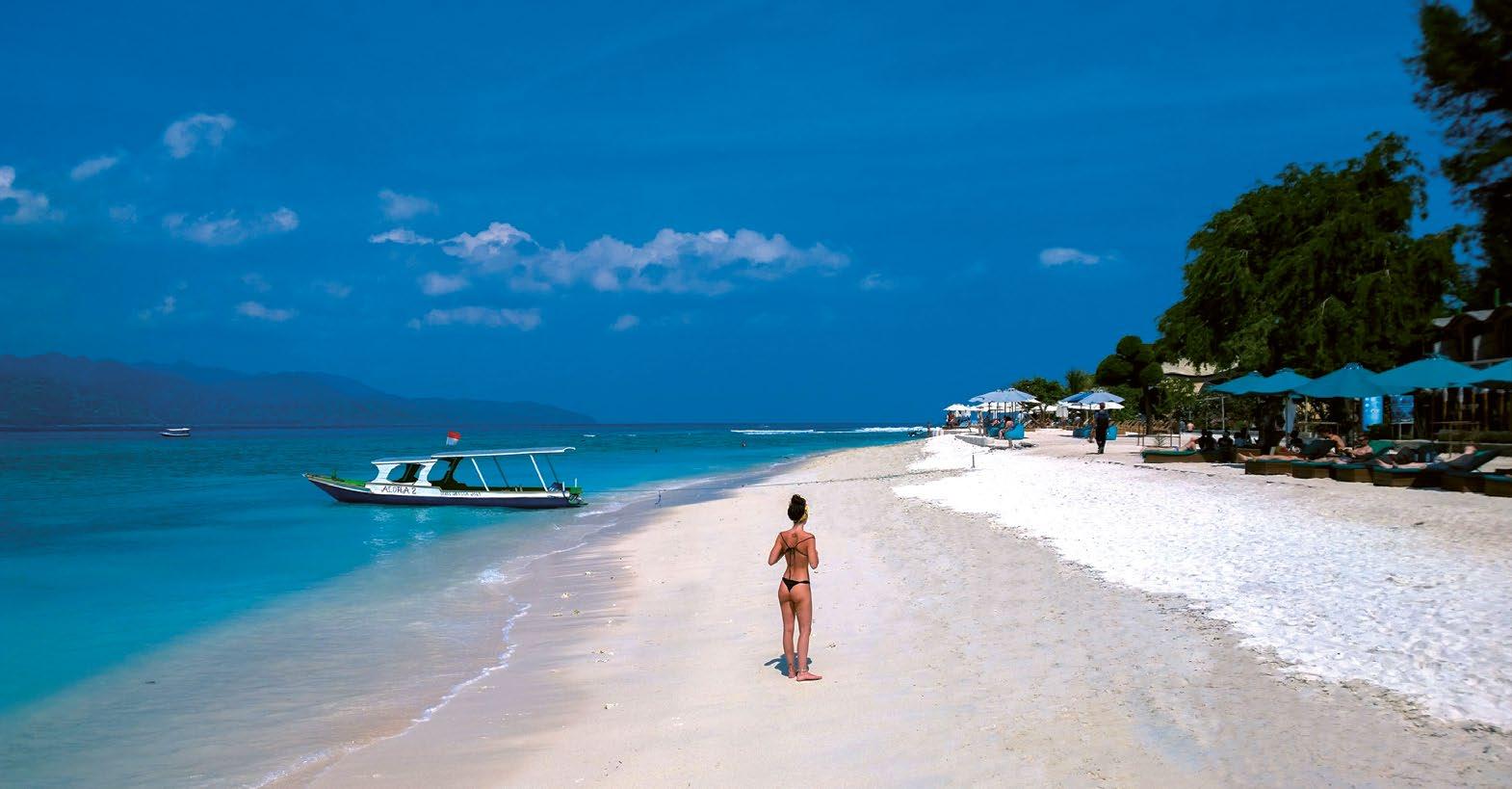
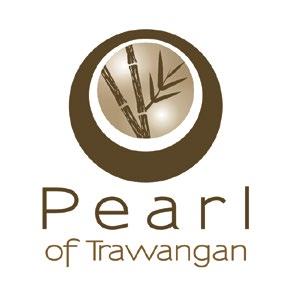

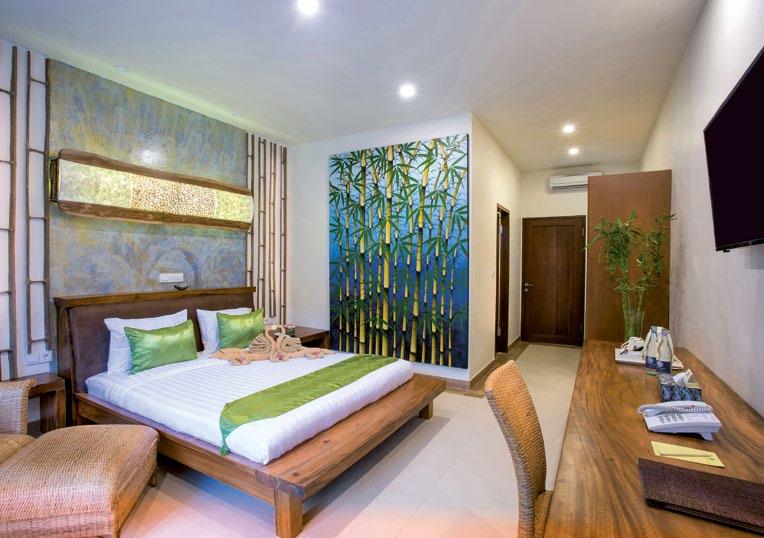
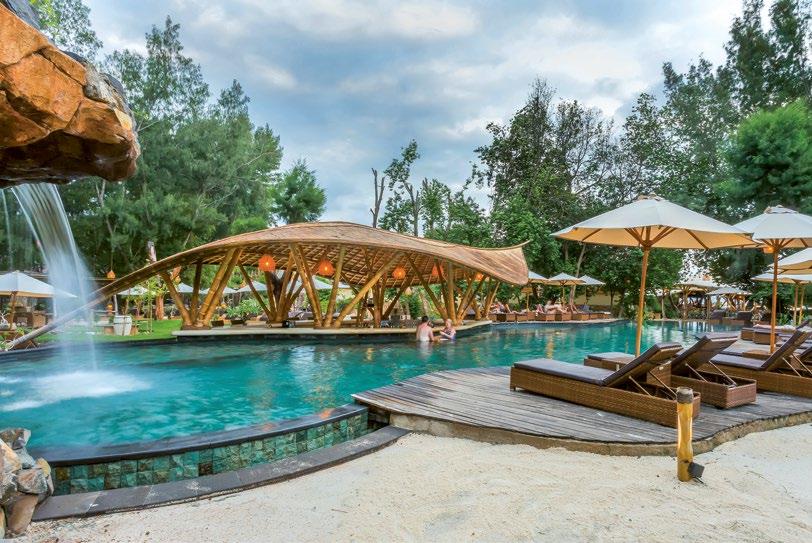
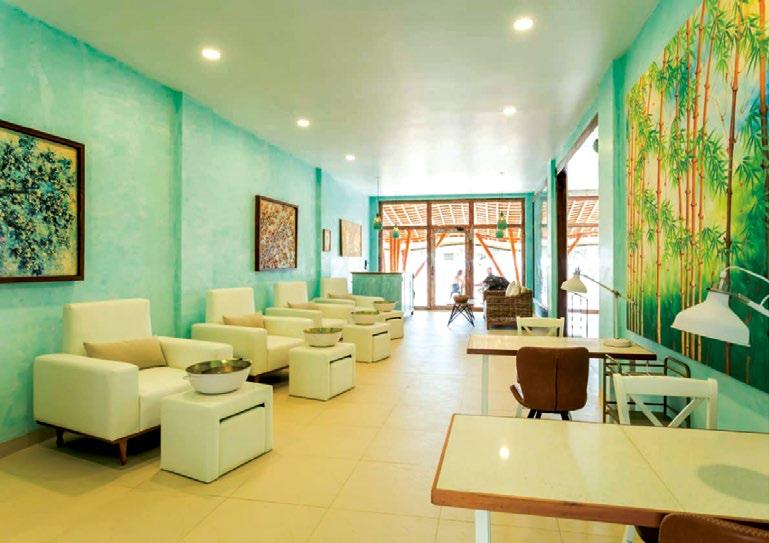
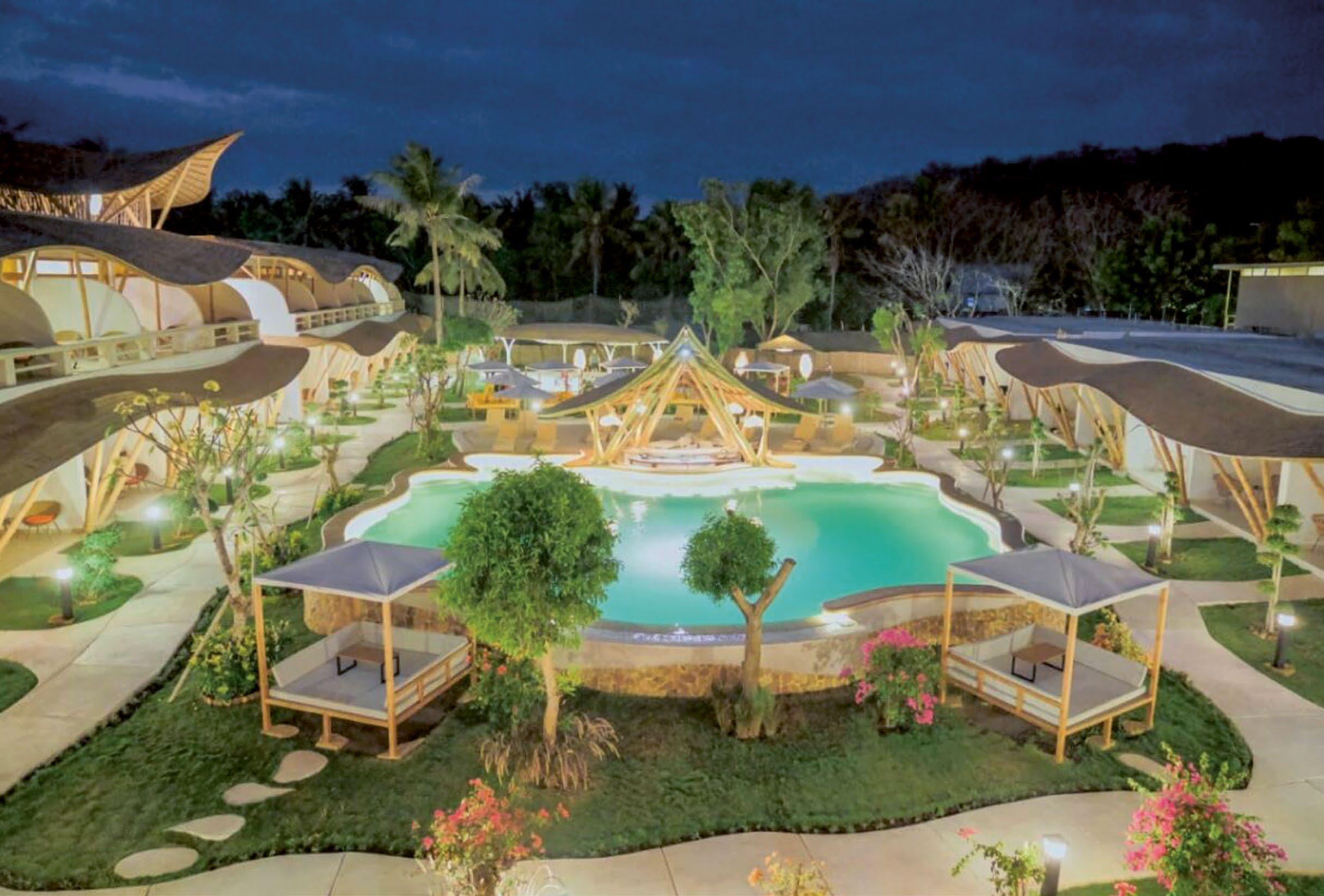


Continued from Page 12
Some of the most popular bars include Tir Na Nog (also called “The Irish”), Savindia Lounge and Bar on the beachfront, and Sama Sama Bar for live music.
For those who prefer quieter entertainment, there are many low-key and romantic options, such as beachside dining, Spas, yoga retreats and more.
The busiest area, called ‘Sentral’, is on the east of the island, close to the harbour. Here you will find the greatest number of bars and restaurants, many hotels and resorts, and lots of shops and activities.
Resorts, restaurants, dive centres, bars, shops and other businesses line the paved ‘road’ that runs around the entire coast of the island.
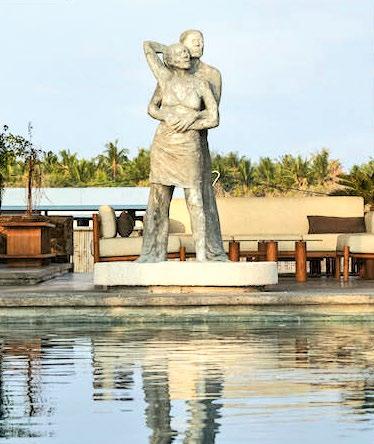
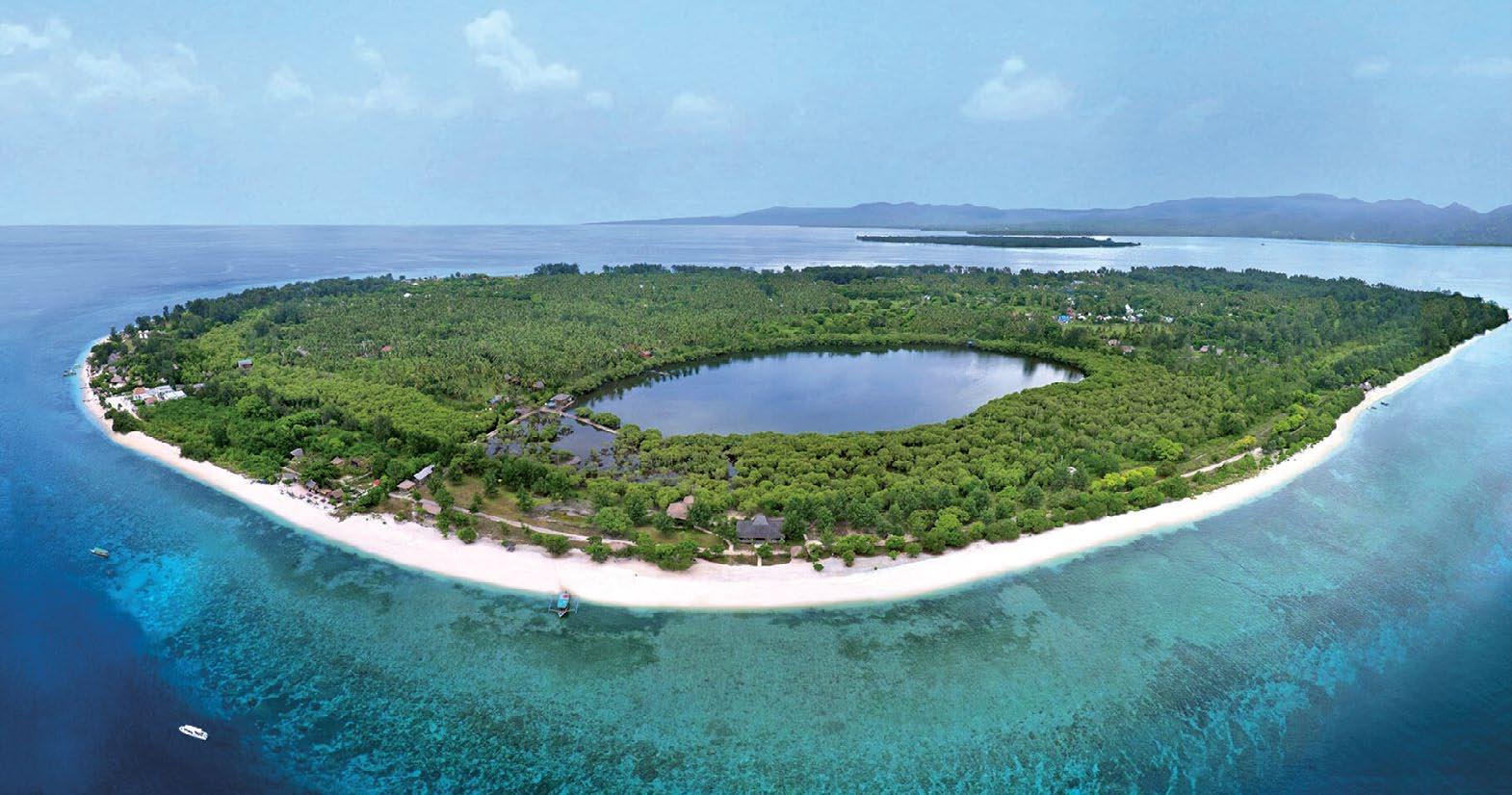
Small roads meander inland from the main coastal road, where many of the island’s local people live. Home-stays, small hotels and private villas here offer a quieter (and often cheaper) alternative to the beachfront choices.
The north coast of Gili T has a quieter vibe and offers a peaceful alternative to the central area. Although the beaches to the north are affected by tides, the views are beautiful and snorkelling from the beach is good. The location makes it easy to access the dining and nightlife options nearby but also offers a different, more natural side of the island.
Likewise, the south and west coasts are popular with travellers seeking a quieter retreat away from the crowds. While still within easy reach of all the action, the hotels and villas offer a more serene island
experience and the sunsets across the sea to Bali are magical.
Gili Meno in contrast, exudes serenity, with its pristine white sands and turquoise waters creating an intimate haven for those seeking seclusion and romance.
Located between Gili Air and Gili T, Meno is the smallest island and has the lowest population of the three Gilis.
Gili Meno is also famous for the many turtles that live just offshore. To swim with these huge creatures – usually so awkward and ungainly on land but moving through their natural element with such grace – is perhaps the most special underwater experience of all and a major reason for visiting Gili Meno.
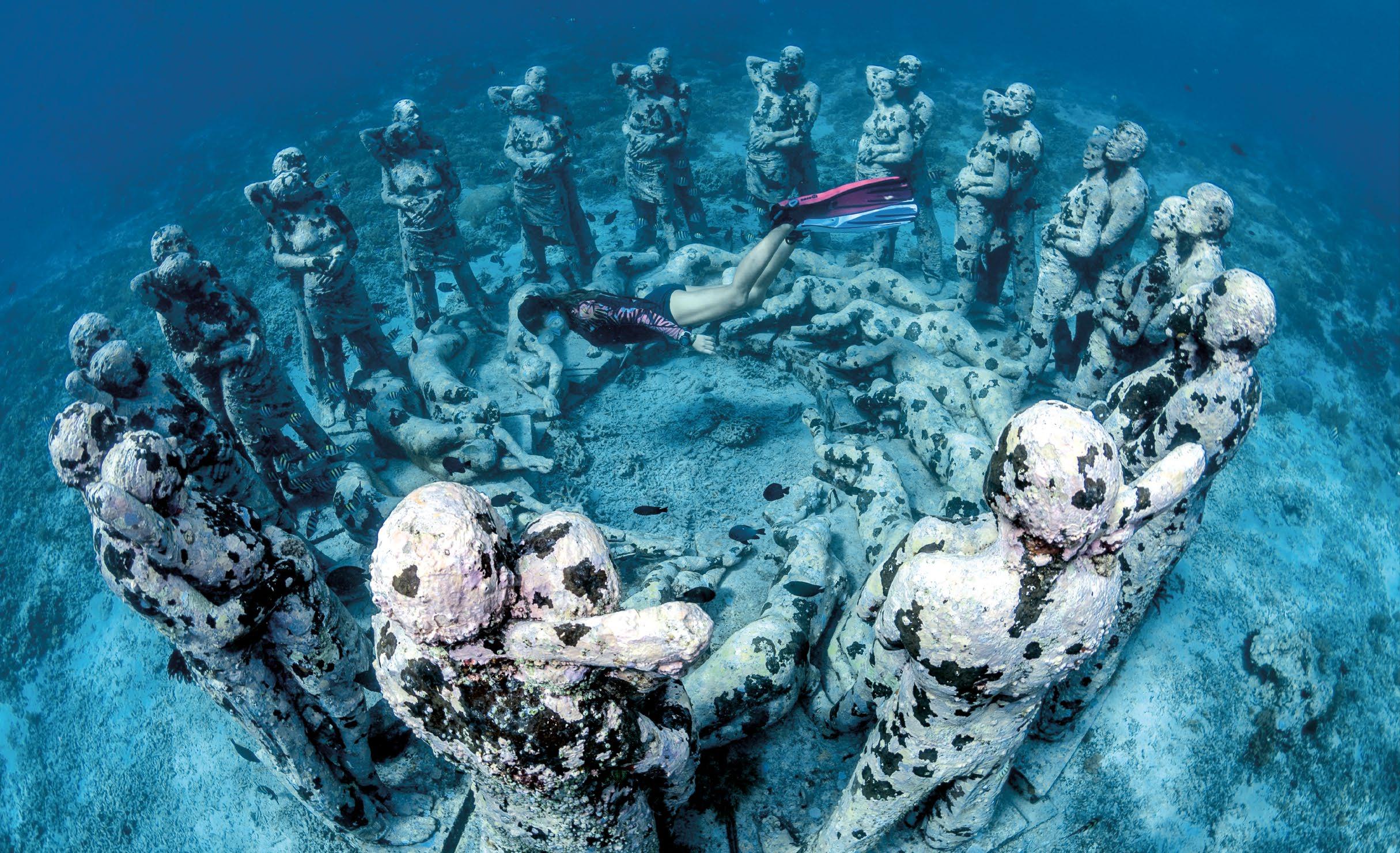
Continued on Page 16
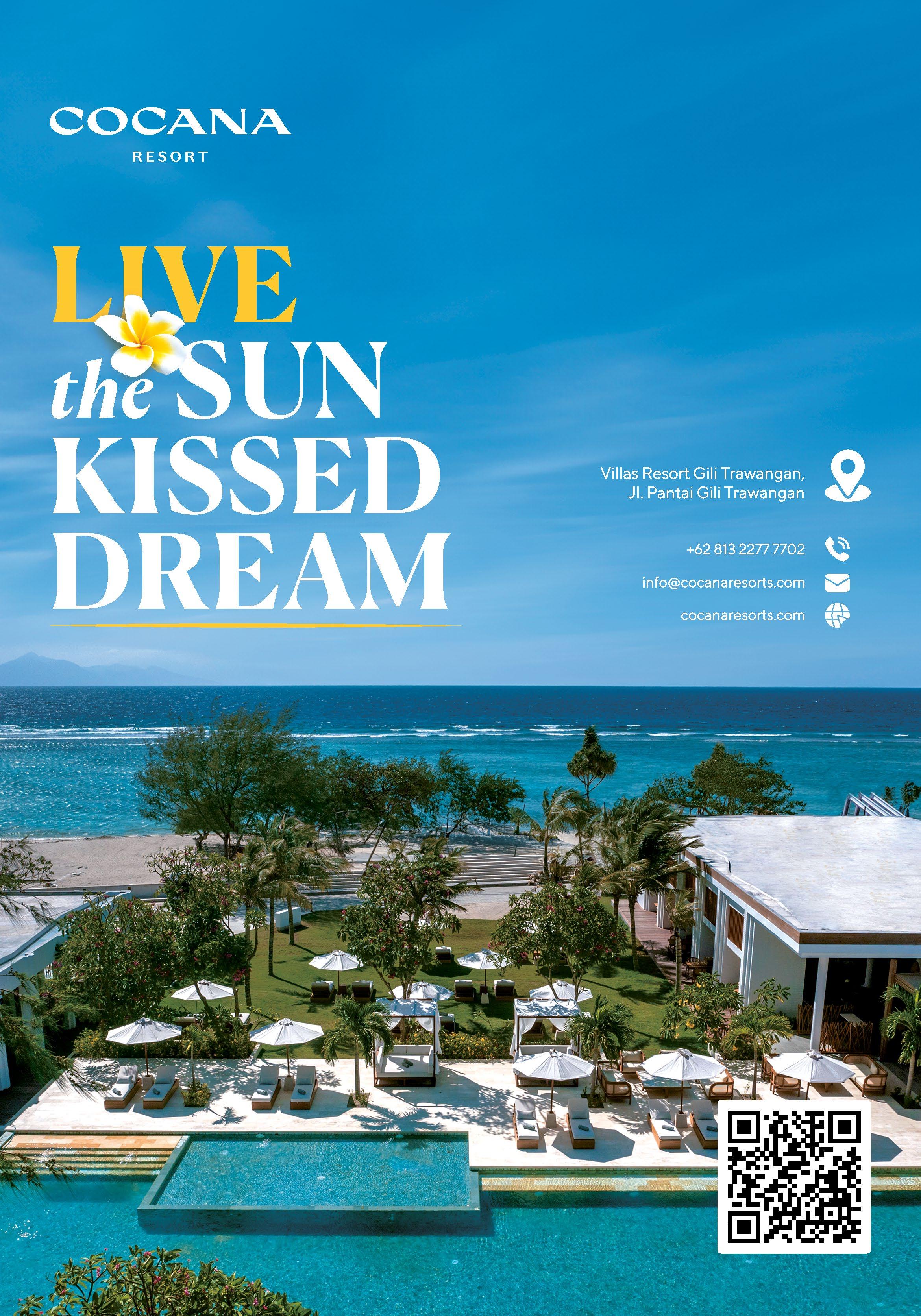

Continued from Page 14
Meno’s popularity has soared over the past 5 years as travellers discover this ‘quieter Gili’ with its beautiful undeveloped beaches and rustic charm – all within easy reach of the diving and activities that have made the Gilis famous.
If you base yourself on Gili Meno, it is easy to dive around the other islands and to make day trips to Gili T and Gili Air via public boats and private boat charter.
The water surrounding the island is clear turquoise and the beaches are covered in brilliant white sand, fringed with coconut palms and native sea pines.
Like all the Gilis, the best swimming beaches and the most tourist facilities (including the boat harbour) are located along the east coast.
It is possible to walk around the whole island on a small beach track in around 90 minutes. Those seeking tranquillity head to the north and west coasts, where more development has been quietly taking place over the past years.
The recent opening of BASK Resort and Beach Club sets a new standard for Gili Meno with its luxurious contemporary villas and suites. The stylish Beach Club

features a layered poolside terrace and beach bar, an open-plan kitchen serving upmarket cuisine, and sophisticated entertainment.
BASK is also responsible for the installation of the popular underwater sculpture called “The Nest”, featuring 48 life-size human figures standing in a circle and entwined together on the ground.
The art installation by famous sculptor Jason deCaires Taylor is hauntingly beautiful and well worth a visit.

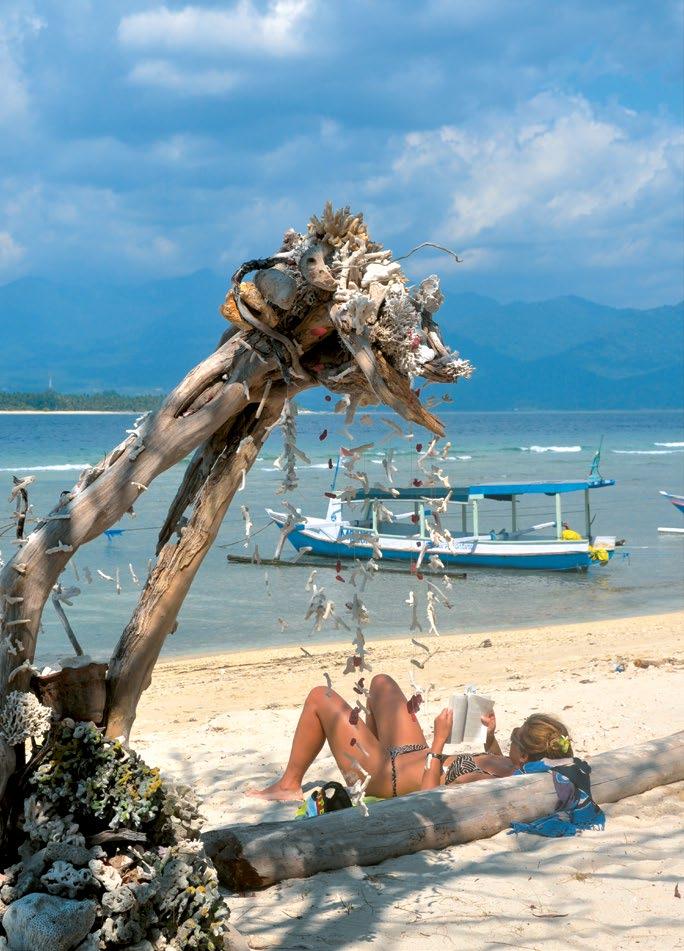
Snorkelling trips often include a visit to the sculpture and the statues draw crowds of snorkellers every day; get there early to see it at its best.
Gili Meno boasts some beautiful quiet beaches and quality accommodation with smaller resorts and private villas dotted around the island.
Small hotels and bungalows provide accommodation for those seeking a peaceful place in the sun with uncrowded beaches, clean waters and peaceful nights under the star-filled skies.
Continued on Page 18


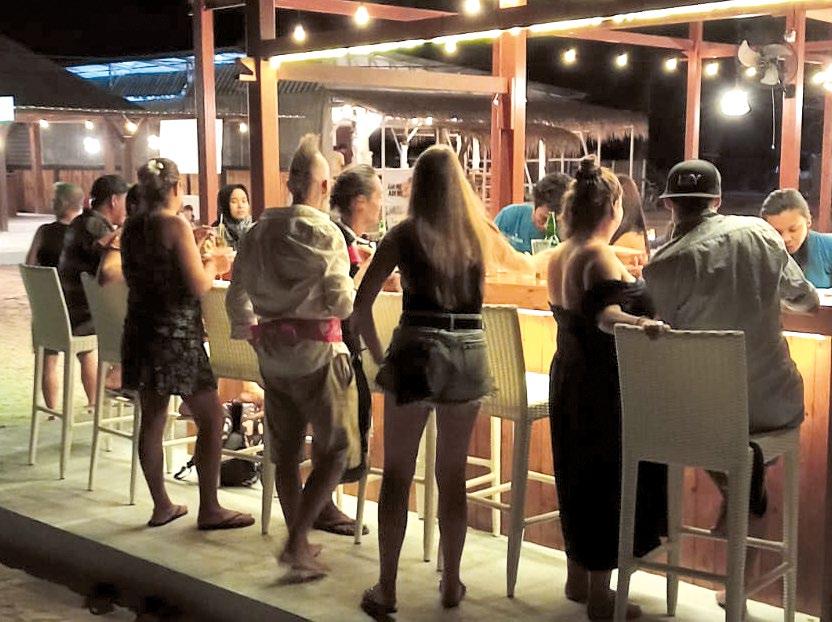

from 10am – 10pm daily North Beach, Gili Meno

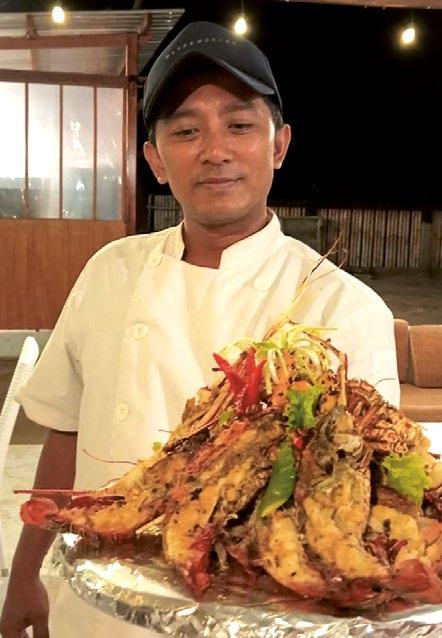
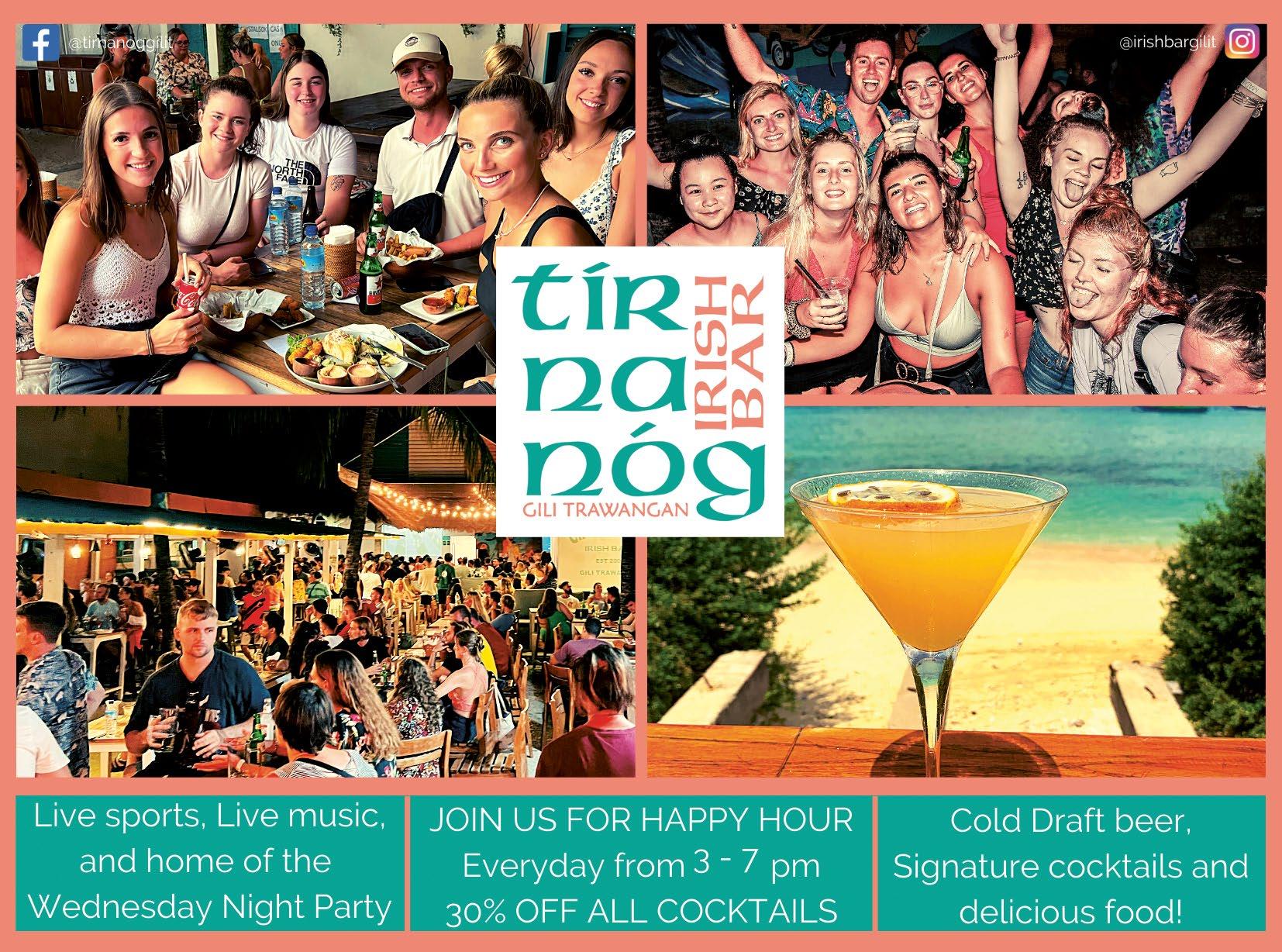
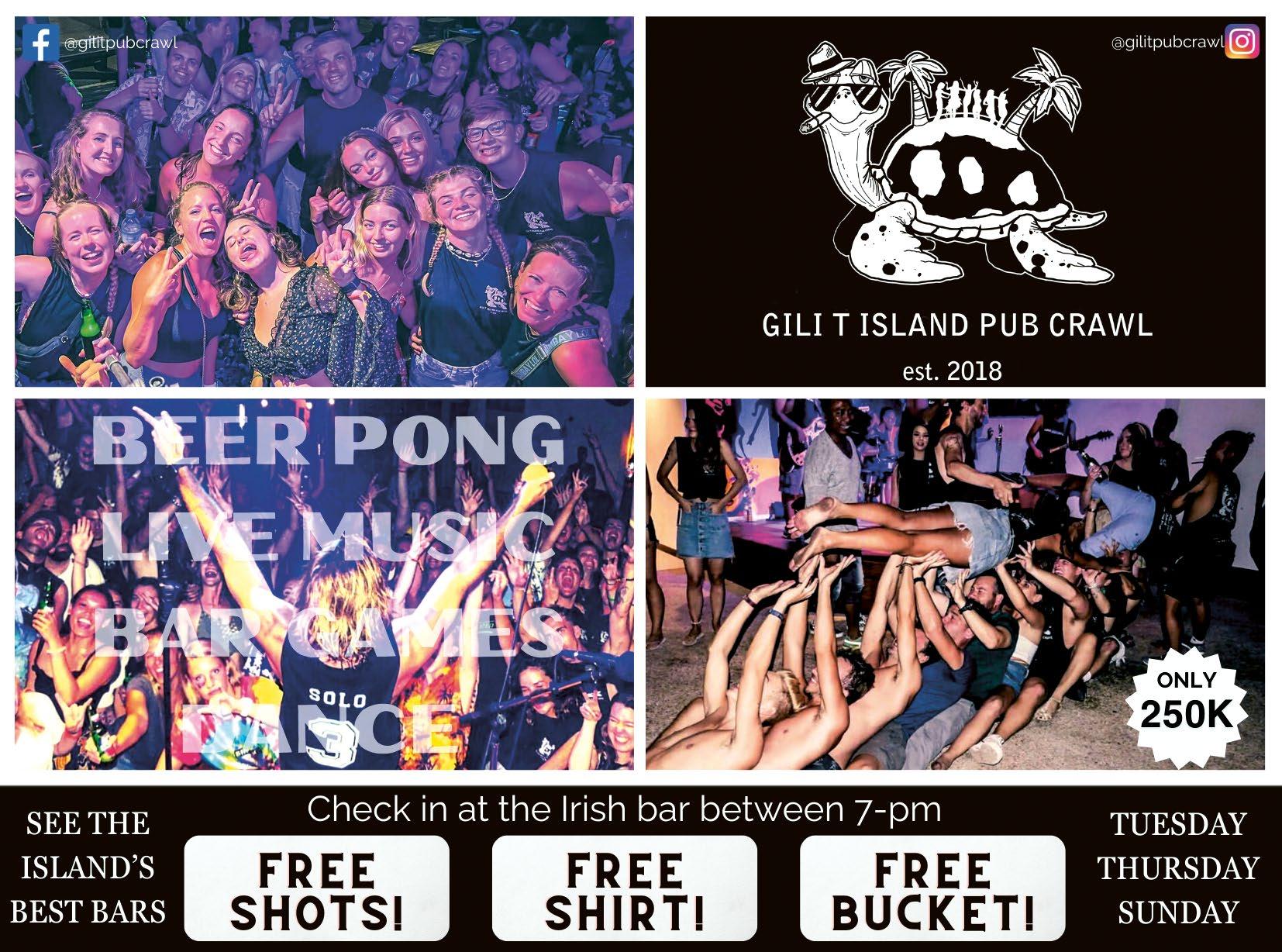
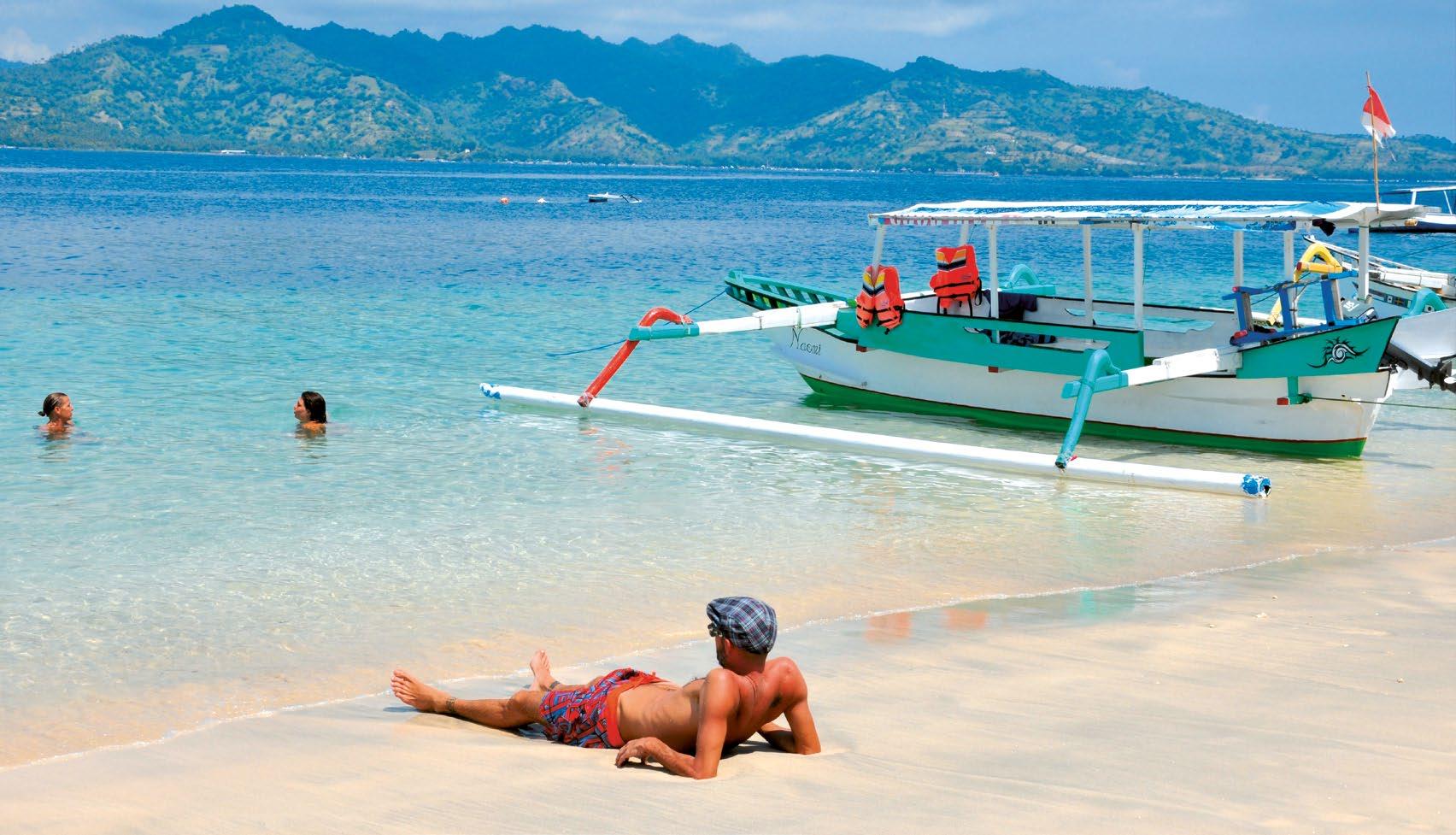
Continued from Page 16
Dotted around the island, casual beachfront cafés and bars serve Indonesian and popular western meals, with fresh fish and wood-fired pizzas being Gili Meno specialties.
Some provide low-key entertainment in the evenings, more so in the high season, but visitors to Gili Meno largely come for romantic escapes and a chance to rejuvenate on the island’s pretty beaches.
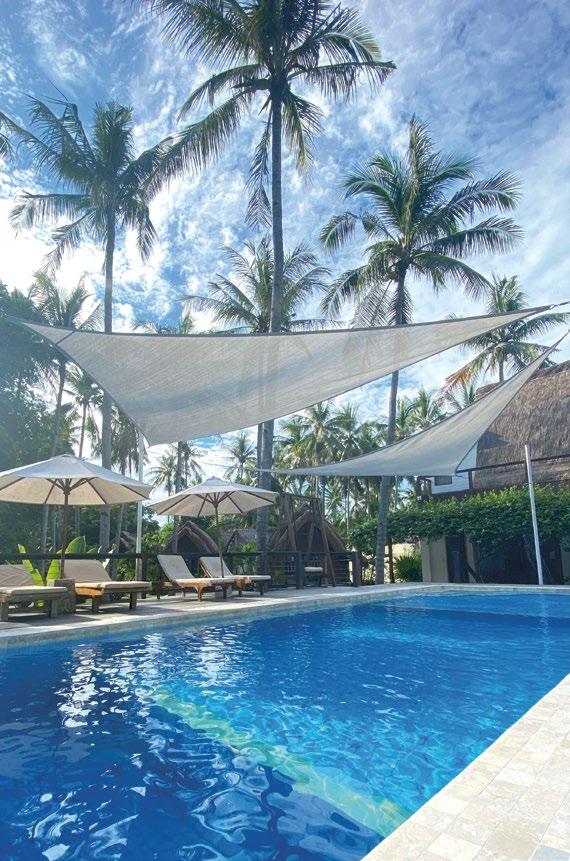
Gili Air has a relaxed, friendly and attractive bohemian vibe, quite distinct from the other islands. It offers a good balance between the buzz of Gili T and the chill of Gili Meno, and draws guests to return year after year.
Gili Air is the island closest to the mainland and can be reached in around 20 minutes by local boat or five minutes by speedboat.
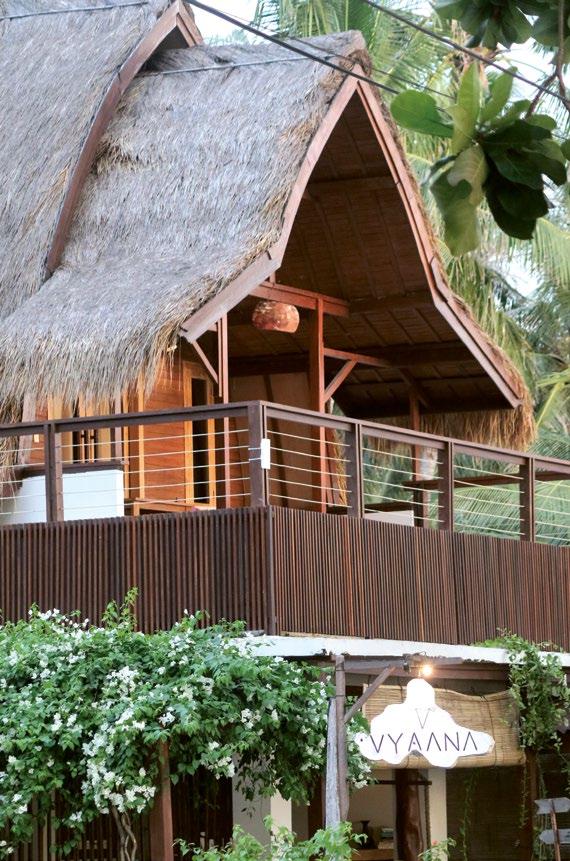

Located within a grove of coconut trees, on the quiet, west side of the island, VYAANA features 7 traditional lumbung villas and 1 suite room enhanced by modern technologies and amenities. This luxurious setting accompanied by 14m ocean view pool provides our guests with a high standard of comfort, security and fantastic sunset views over the island of Gili Meno.
For those who have never had the pleasure of viewing the magical world beneath the ocean, Gili Air offers a superb opportunity to do so in safety and comfort. Other activities on the island include yoga and meditation classes and retreats, cooking classes, browsing the quaint shops, relaxing massages and body treatments, and simply chilling out on a beautiful little tropical island.
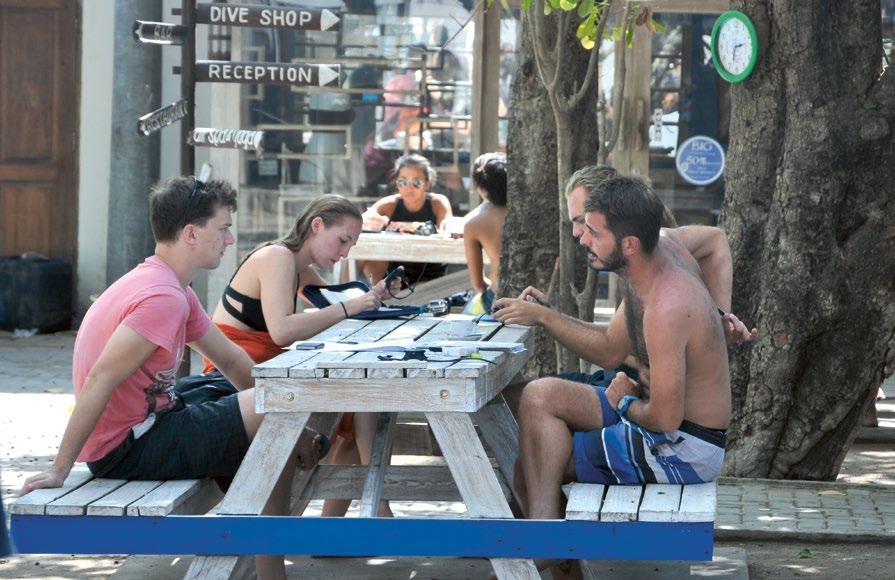
Continued on Page 20
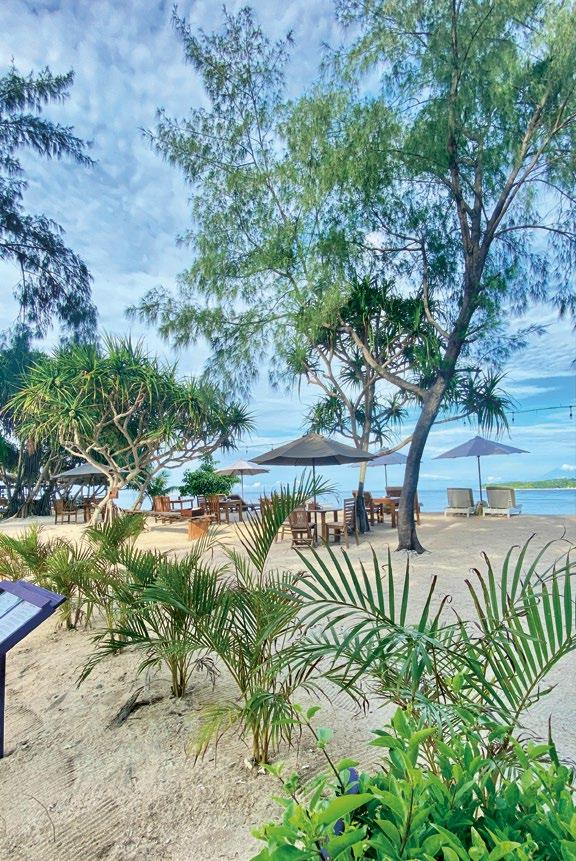
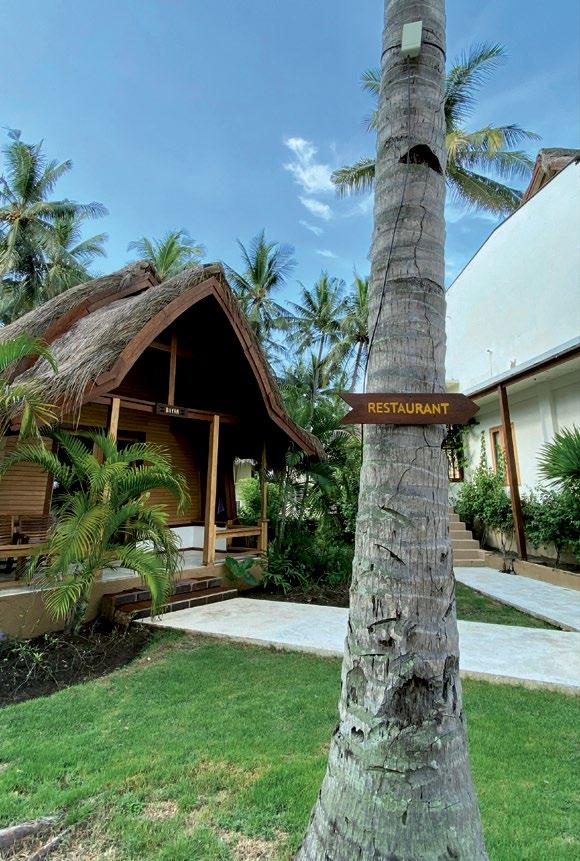
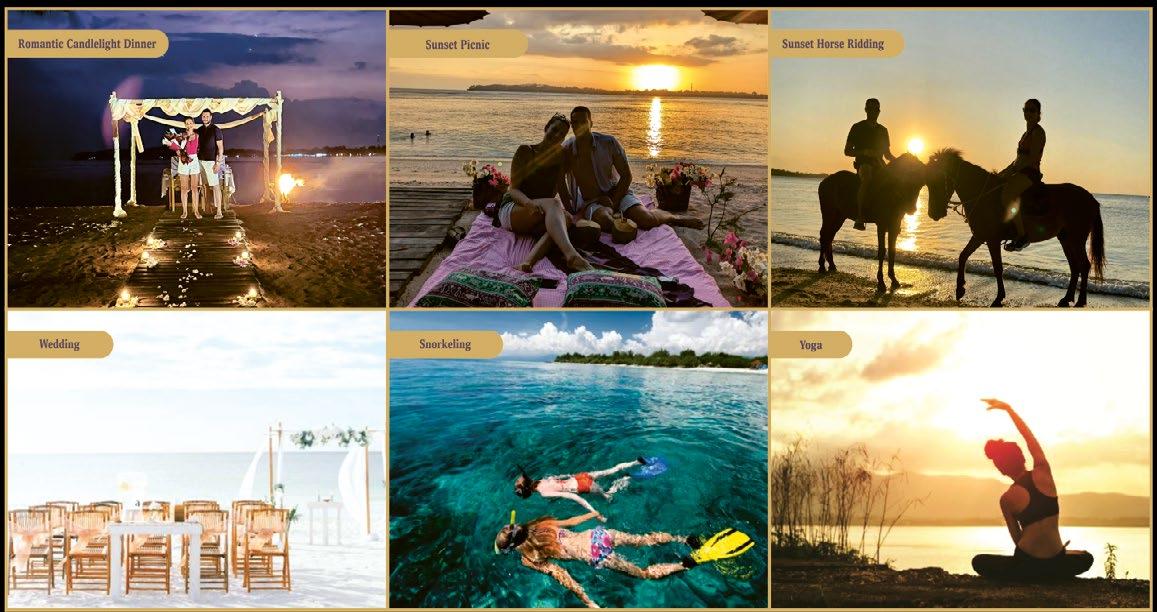



Being the closest of the Gilis to the mainland, Gili Air has the largest local population of the three islands; combining the charm of a tropical island with the people and culture that make Lombok unique.
Like all the Gilis, the best swimming beaches are on the east coast and most development runs along the beaches here down to the harbour in the south.
The views from all points of the island are stunning but the east coast, facing Lombok, is probably the most fantastic – looking back at the big island with its white beaches and green mountains dominated by Indonesia’s second largest volcano, Mt Rinjani.
Accommodation on Gili Air ranges from simple back-packer bungalows to luxurious air-conditioned rooms and private villas with swimming pools.
There is a good variety of restaurants and beachside cafés on the island, offering everything from traditional Indonesian dishes to up-market international fare, while vegetarians and vegans are well catered for too. Fresh seafood is readily available.
The bar scene can get pretty lively in the evenings and, during high season, the island kicks into high gear with Full Moon parties on the beach. Alternatively, pull up a seat at one of the beach bars and enjoy live music by some talented local musicians.
Activities include walking and cycling around the island, sun bathing, and swimming, excellent diving opportunities,
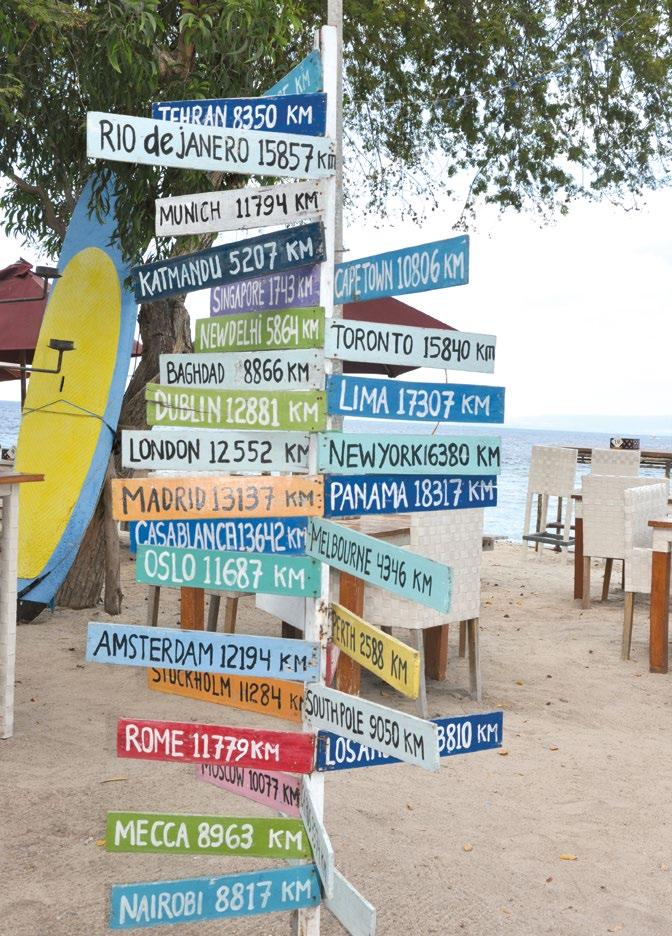
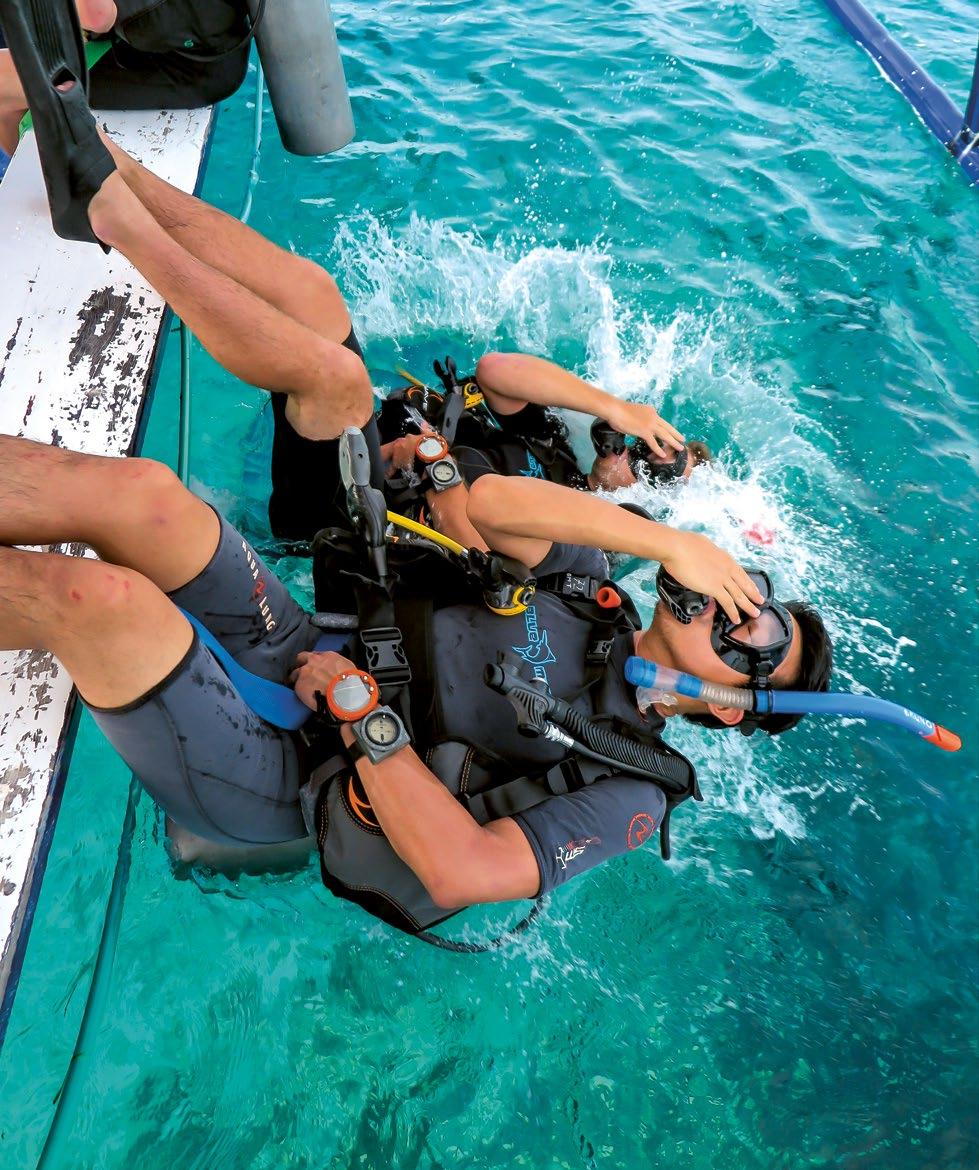
snorkelling from the shore, free diving, thrilling Subwing adventures, stand up paddle boarding, surfing and other water sports.
For exploring, there is a path running parallel to the beach and it takes around 90 minutes to circle the whole island. The interior is criss-crossed with a maze of tracks that can get confusing, but all lead back to the beach.
The calm waters and good visibility make Gili Air an ideal place to learn to dive or to upgrade diving skills. There are a number of professional dive centres on the island and, of course, it is easy to explore the other islands from here.
Popular dive sites on Gili Air that attract divers from the other Gilis include Air Wall off the west coast, Hans Reef and Frogfish Point off the north coast.
The water surrounding the island is a clear, translucent aquamarine, made even more pure by the sparkling white sand beneath.
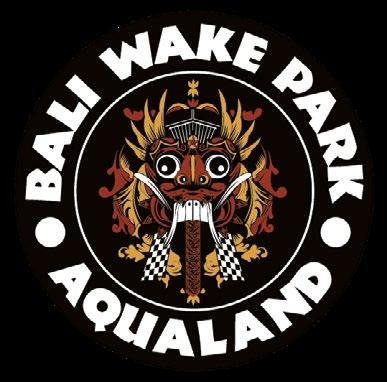


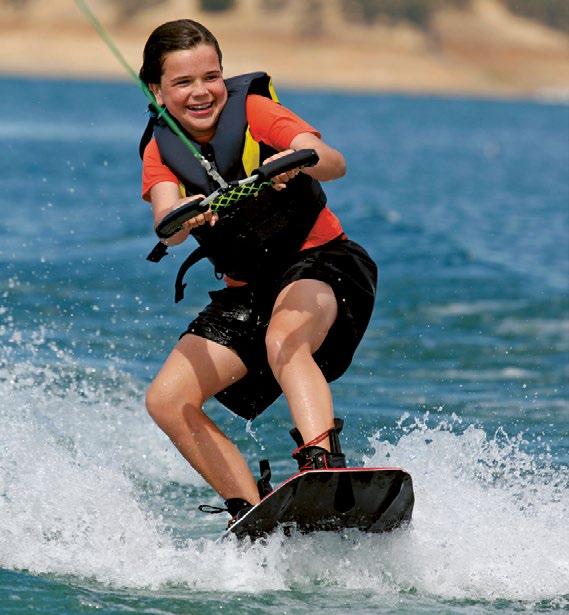


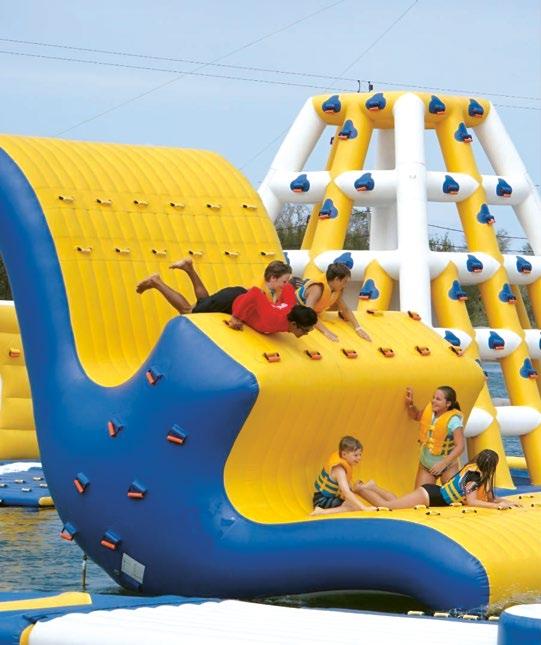


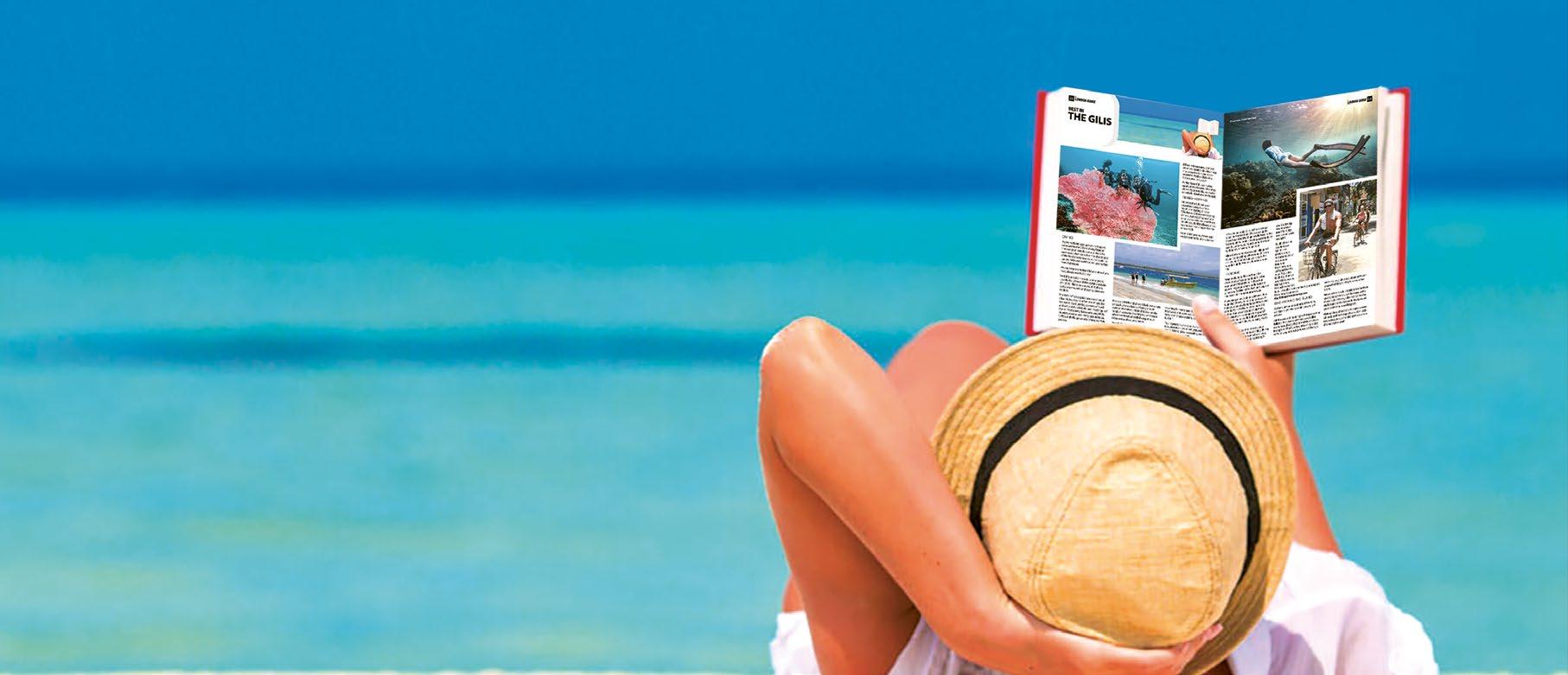
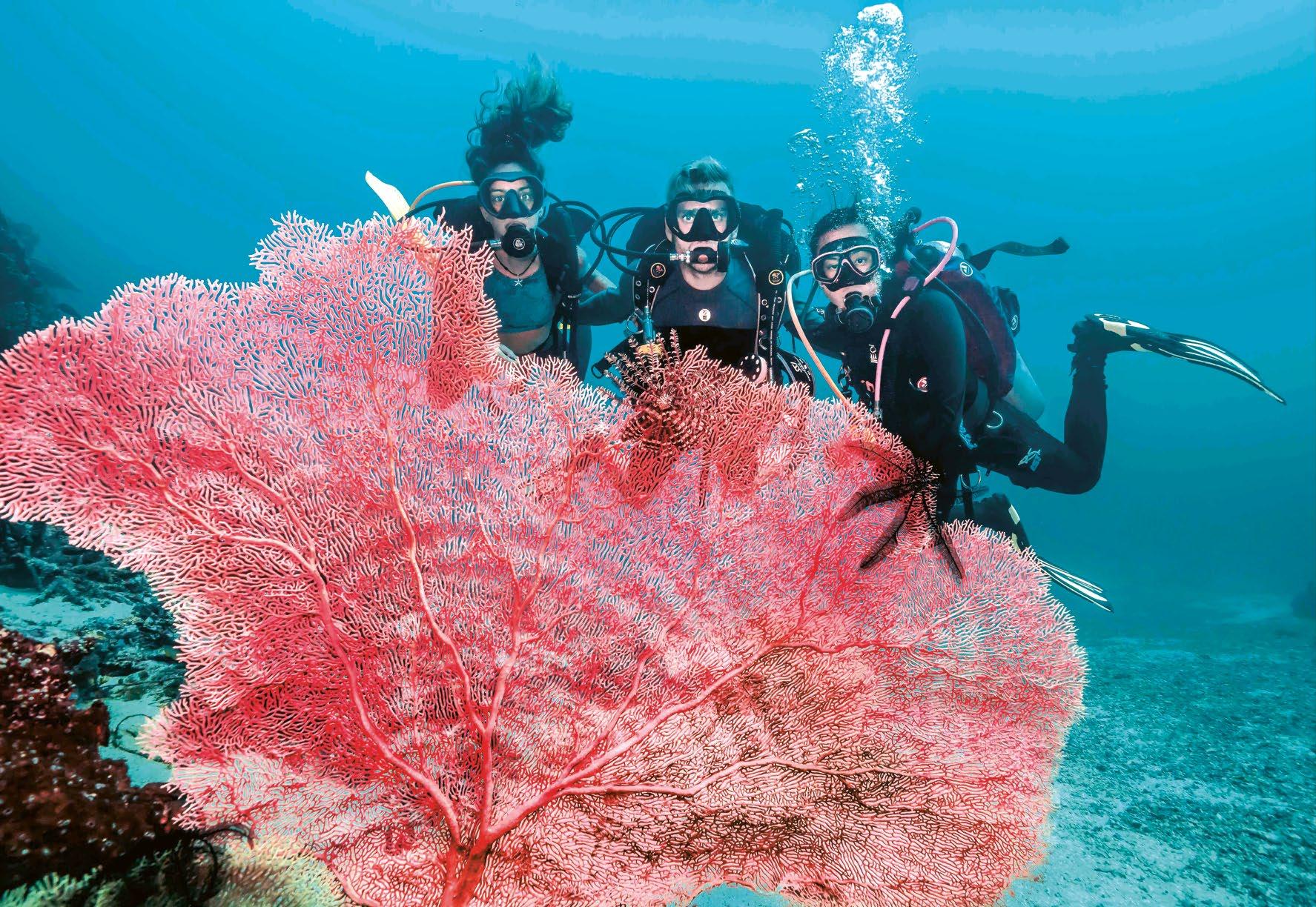
It goes without saying that the biggest drawcard to the Gilis is diving! Tens of thousands of people come to the Gilis each year, whether to learn to dive in one of the best environments in the world, to update skills and certification, and to find new challenges.
It’s a great place to learn how to dive if you have always wanted to try!
Visibility around the Gilis is very good, usually 15 - 25m and the water is a warm 28 - 30ºC. There are slopes, drift dives, walls, sea mounds and even a wreck to explore.
The Gili’s reflect a good cross-section of what SE Asia has to offer. Dive in and be fascinated by stunning gardens of hard and soft corals, white-tip and black-tip reef sharks, moray eels, barracuda, angelfish, pipefish, mantas and sting rays, octopus, turtles and a huge variety of tropical fish species.
different languages, so if you are more comfortable learning in your native tongue, shop around to find a school that speaks your language.
As the three Gilis are not far apart, all the famous dive sites are easily accessible, no matter on which island you are based.
Discover the Gilis with an island-hopping tour on a traditional outrigger boat. Whichever Gili you are staying on, you can organise with the boat owners on the beachfront to take you to the other islands to discover the unique charms of each Gili.
From Gili T you might want to cruise over to Gili Meno in the
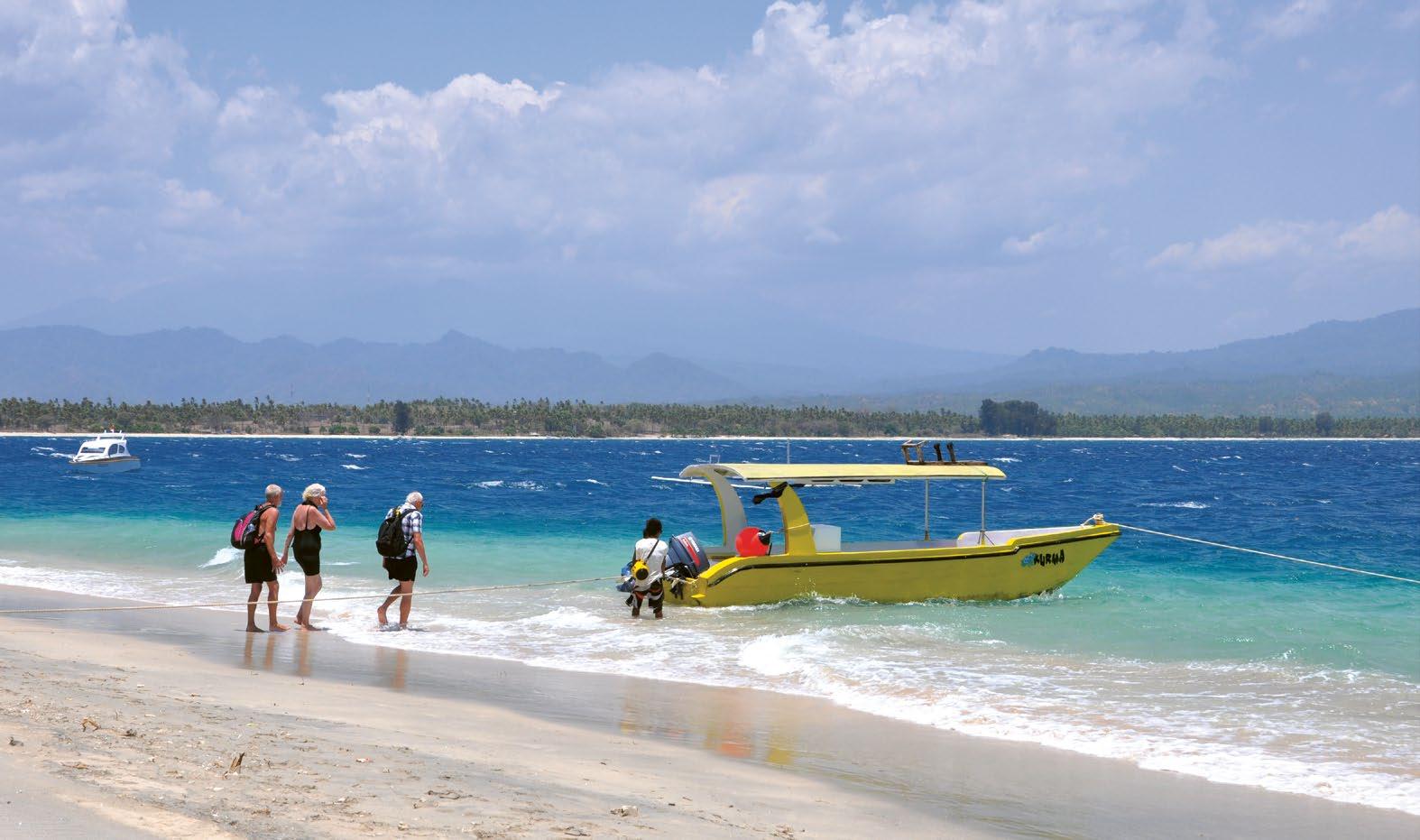
There are PADI and SSI certified dive shops on each of the islands offering a wide variety of courses – from discover scuba to open-water to Dive Master, and more advanced levels of drift diving, rescue diver, nitrox diver, and more.
Dive instructors on the island come from all over the world and speak many
morning for some snorkelling and lunch, then on to Gili Air to explore the island by bicycle and have a swim, before returning to Gili T.
Tour operators and boat owners are happy to customise trips to suit you and to suggest itineraries depending on the tides and best places to see.


It’s even possible to island-hop using a glass bottomed boat. These outriggers have been fitted with an acrylic base in the bottom of the boat, allowing passengers to see the underwater world beneath them without ever having to get wet!
Glass bottom boats are especially good if you are travelling with young children – allowing them to safely discover the wonders under the sea. Fun for parents too!
Want to learn to dive without the restrictions of scuba tanks and all the equipment? Freediving is the art of controlling your breath underwater to allow you to dive in freedom and explore the ocean in a more intimate way.
Freediving allows you to swim and dive wherever you want, as long as you can hold your breath. Experienced freedivers commonly can dive to 30m and more without the use of scuba equipment. Self-awareness is an important part of the sport and many describe it as a form of meditation and deeply relaxing stressrelief.
Even if you just want to improve your snorkelling skills or add to existing diving skills, you will benefit from a freediving session. It also improves lung strength
and breathing, and increases joint flexibility and overall body strength.
Pacific Freedive Academy on Gili Air are professionals with many years’ experience teaching freediving in a safe and friendly way. They offer both Molchanovs and AIDA courses for beginners through to master level, as well as personalised coaching and freediving bootcamps.
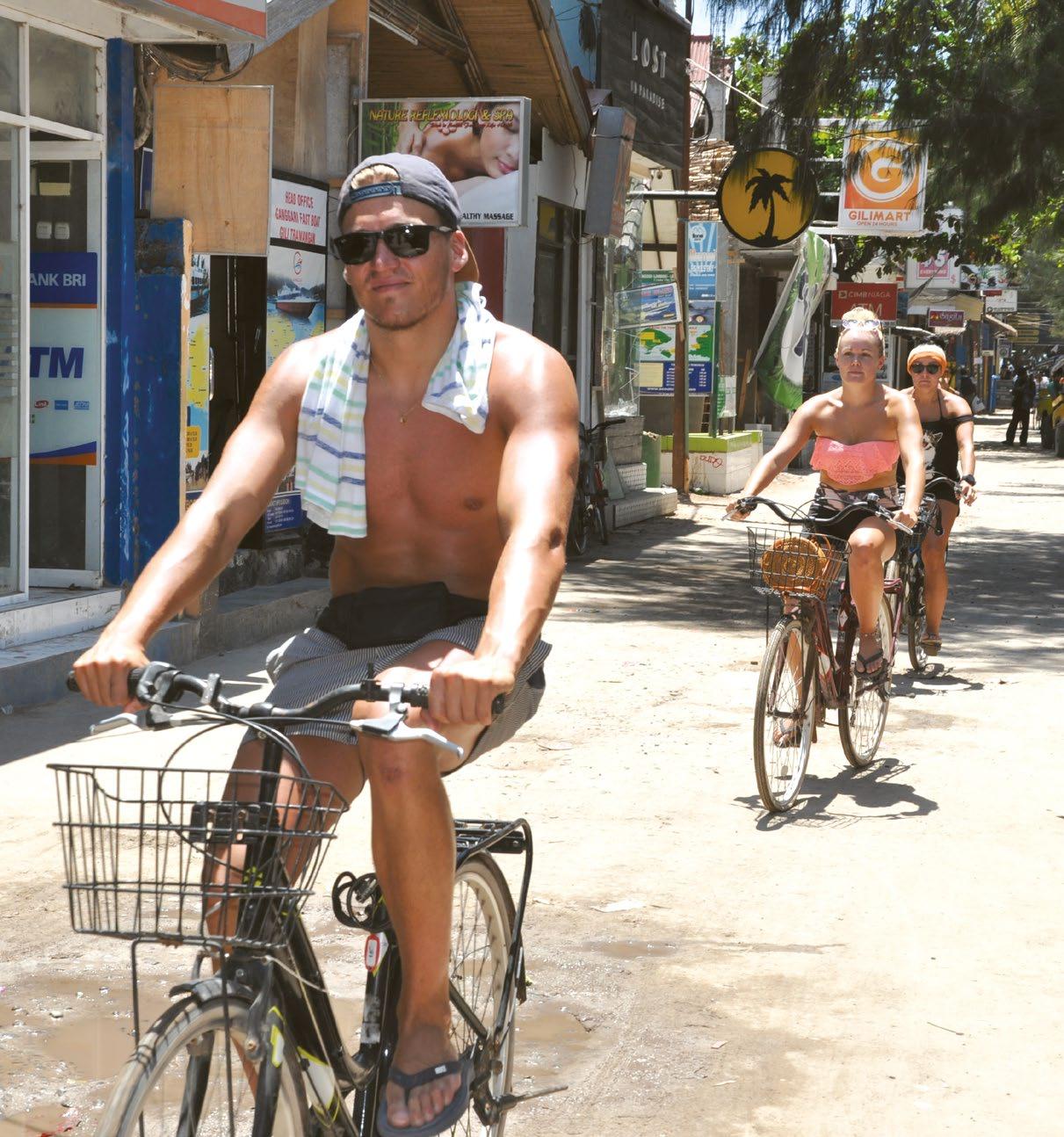
Pacificfreediveacademy.com
As there are no cars on any of the Gilis, riding a bicycle is a popular way to get around.
All three islands have a good ring road that follows the shore and there are smaller roads branching off to inland destinations to explore. There are beachfront bars and cafés to stop at whenever you get hungry
or thirsty, or grab an ice cream or frozen yoghurt while you stop to admire the views.
Many of the hotels provide bikes for their guests to use or you can hire one at the many stalls offering bike hire by the day. Make sure the brakes work, the tyres are good and it has a working bell.
Riding a bike allows you to explore more of the island and stop off wherever looks interesting. Hop on a bike and see where the road takes you!

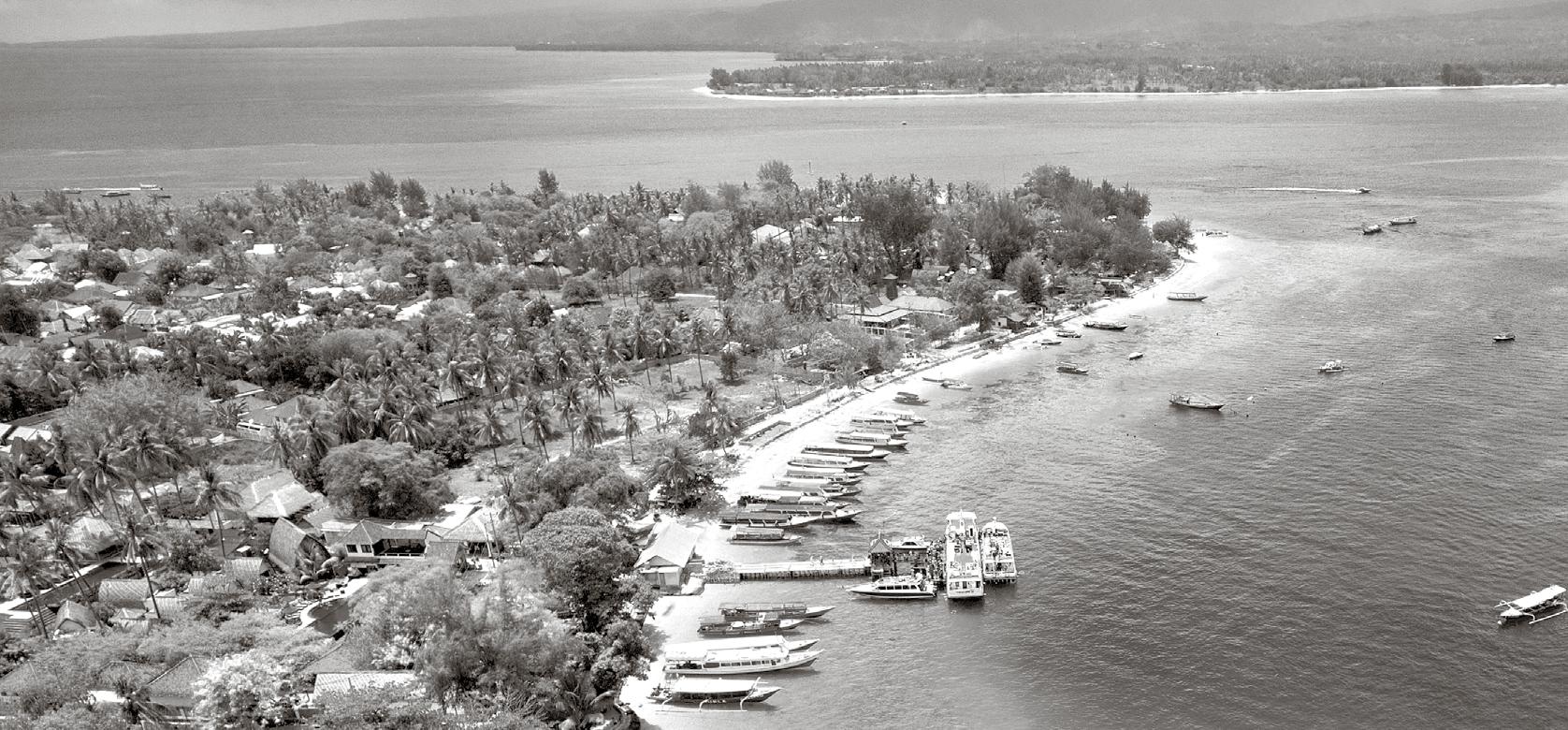
Internet is readily available on the islands and all three islands have ATM machines so you don’t need to carry a lot of cash. Credit cards are accepted at most dive shops and larger hotels and restaurants. Useful Tip: WhatsApp is the most popular messaging service in Indonesia. Download the app to your phone for convenient messaging and phone calls to Lombok businesses wherever there is internet available.
Boats and Island Hopping: Gili Air, Meno and Trawangan are grouped together off the northwest coast of Lombok and only a short distance apart, so it is easy to move between the three islands. You may want to explore each island for a couple of days or base yourself on one and take day trips to the other islands.
Public boats leave from the harbours on each island with transfers to the other islands available roughly every hour, e.g.; Gili Air to Gili Meno, or Gili Air to Gili Trawangan, and vice versa. Prices are reasonable. Purchase tickets at the ticket office located at the harbour on each island. It is possible to charter perahu (local outrigger boats), speed boats and even glass bottom boats for exploring the islands and their magnificent underwater scenery.
Water is a scarce resource on the islands and is supplied by desalination plants
and ground water wells. Your awareness in conserving this finite resource is appreciated; take short showers and opt to reuse bedding and towels.
The tap water on all the islands is not suitable for drinking but bottled water is cheap and readily available.
Weather is generally hotter on the islands than mainland Lombok. Make sure you drink plenty of water to stay hydrated and use sun protection, even on cloudy days.
Transport: There is no motorised transport on any of the islands. Walk, ride a bicycle or catch a cidomo (local horse cart). None of the islands is very large, so walking is an easy option.
the islands. Negotiate the fare with the driver before climbing in. Generally, short distances will cost between Rp 50,000 –100,000; depending on your bargaining skills.
Bicycles can be hired for around Rp 50,000 per day, depending on the type and condition of the bike. Some hotels provide bikes free of charge for guests.
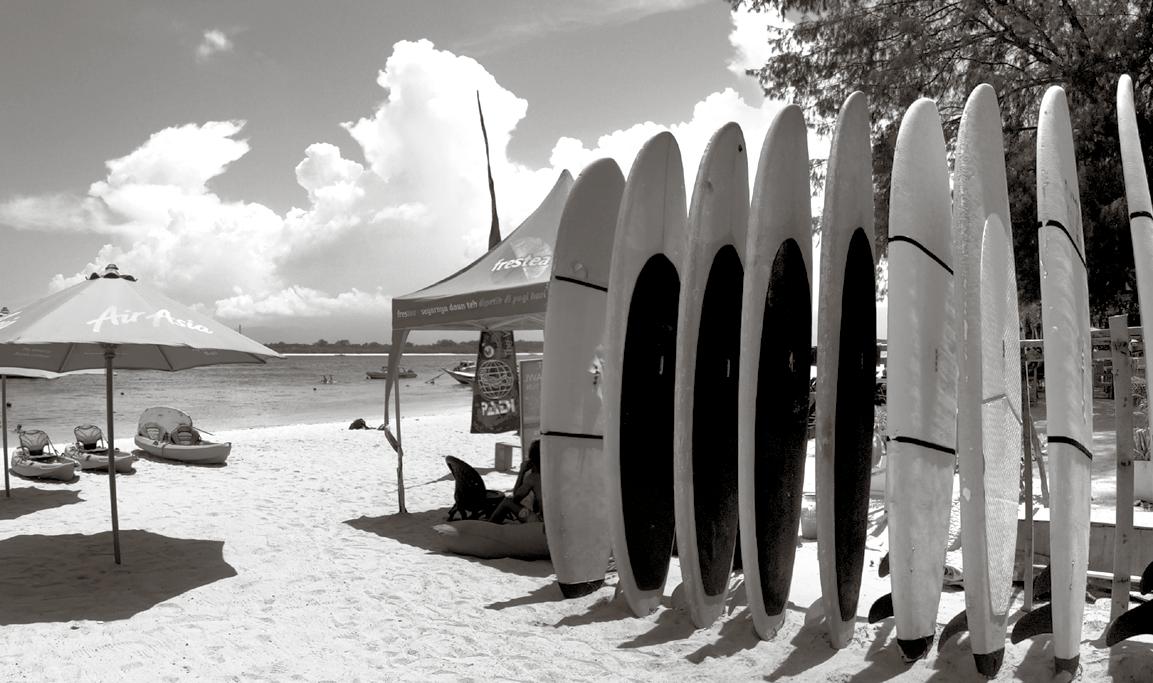
Cidomo (pronounced ‘chi doh moh’) are traditional horse drawn carts that were once the main form of transport in Lombok. The covered wooden carriages are pulled by small local ponies and are used for transport on the Gilis, and for carting goods.
Use cidomo for short trips, such as getting to restaurants and hotels around
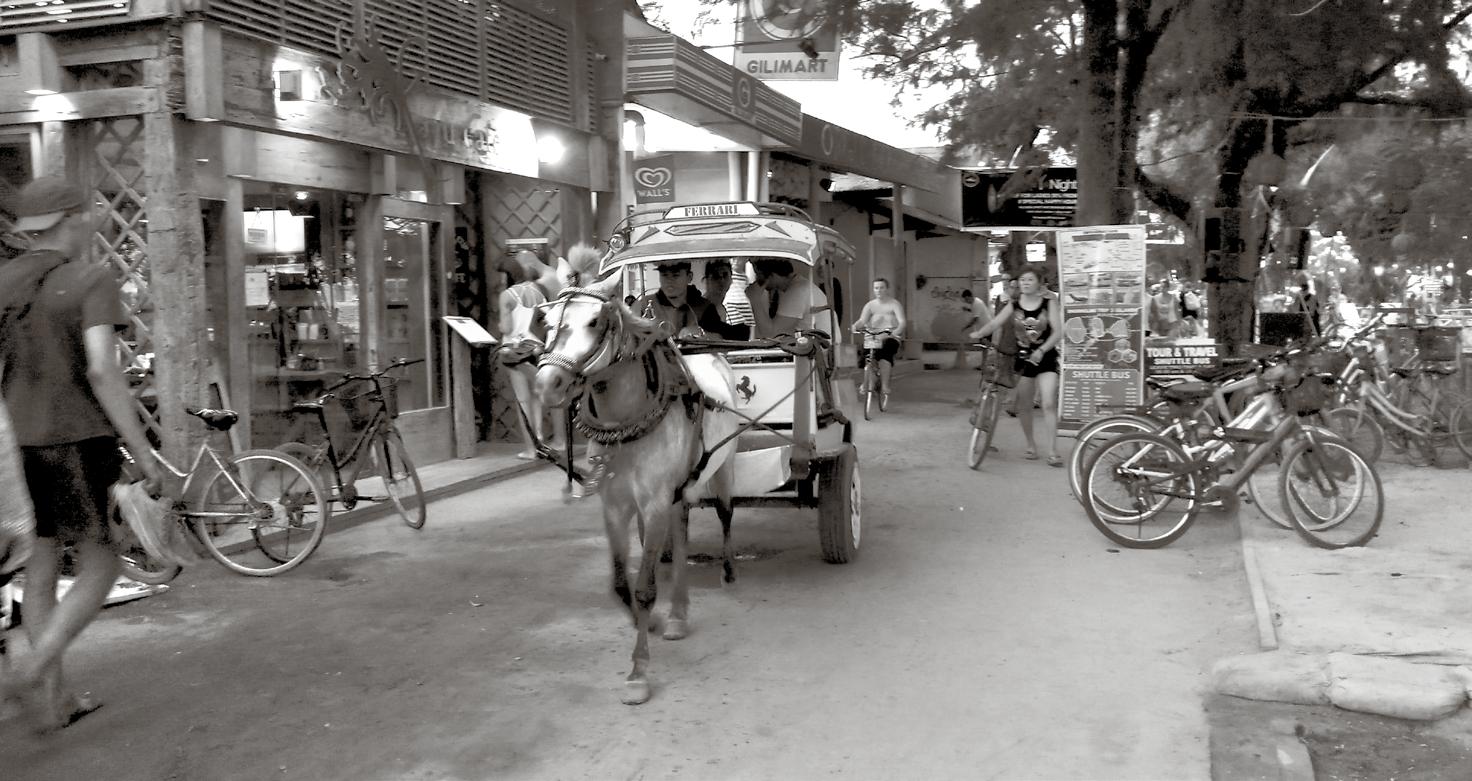
Dress is casual on the islands and it’s normal to see tourists walking around in sarongs and shorts. Bikinis are fine on the beaches but it’s polite to cover up when walking around the streets or going to restaurants and bars. Remember that the islands’ residents are Muslim and nude or topless sunbathing is frowned upon. Please respect island culture.
Luggage Storage in Bali: If you’re travelling with too much baggage or extra equipment such as surfboards, you can take advantage of a great offer from Bali Wake Park in Benoa, just 5 minutes from the airport. Spend some time trying out their fun range of water sports or simply have a drink and a meal before or after your trip to Lombok and the Park will give you free storage facilities until you return. If you have a late flight, you can spend the afternoon swimming and have a cold beer before you head to the airport. See opposite page.